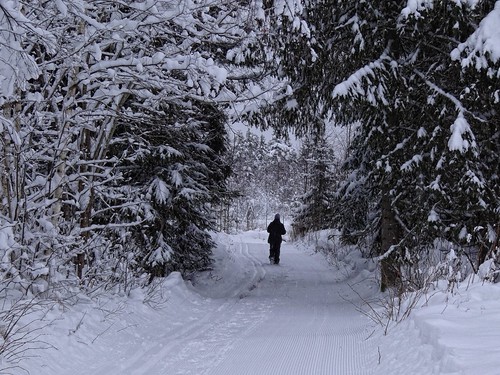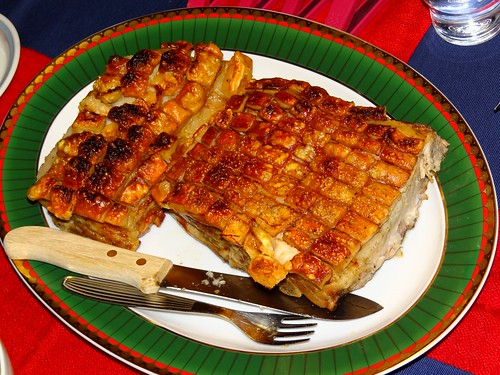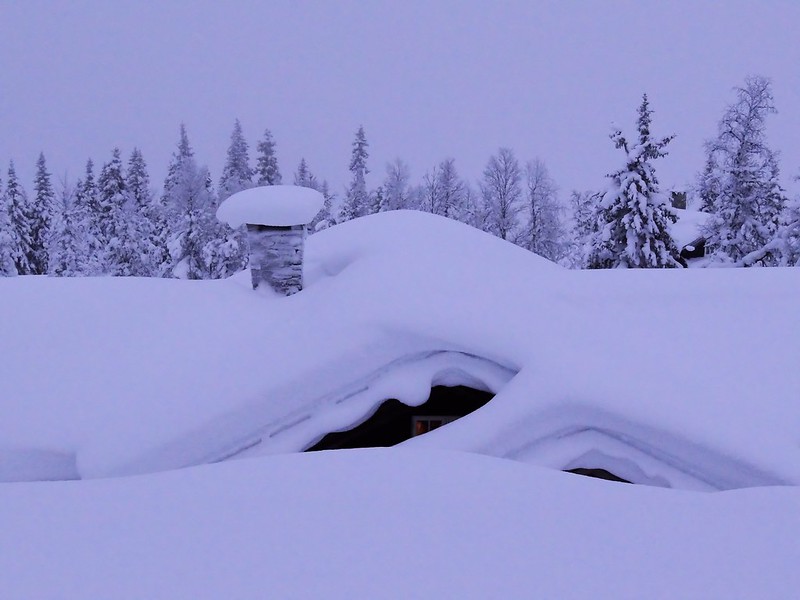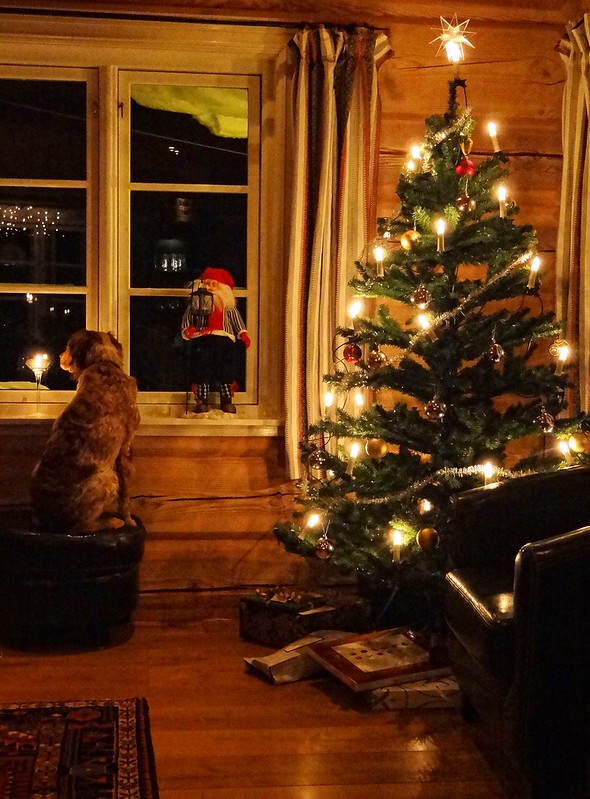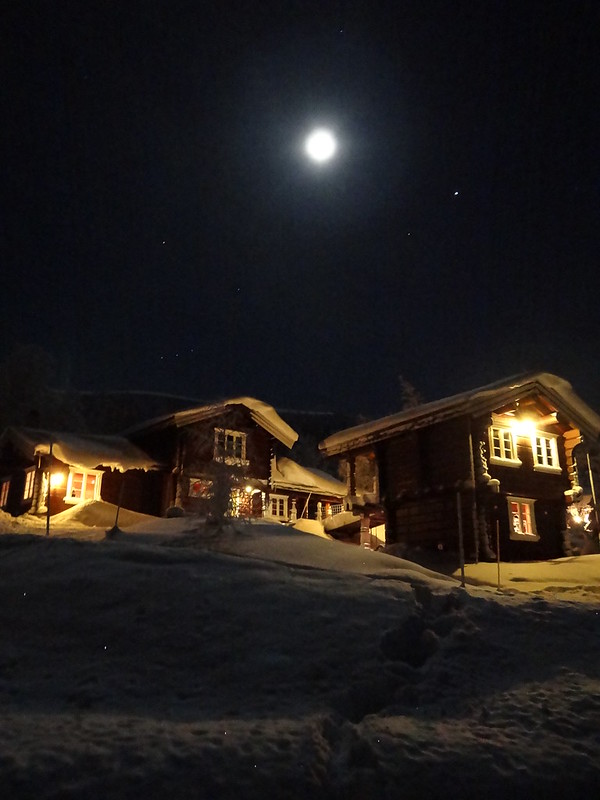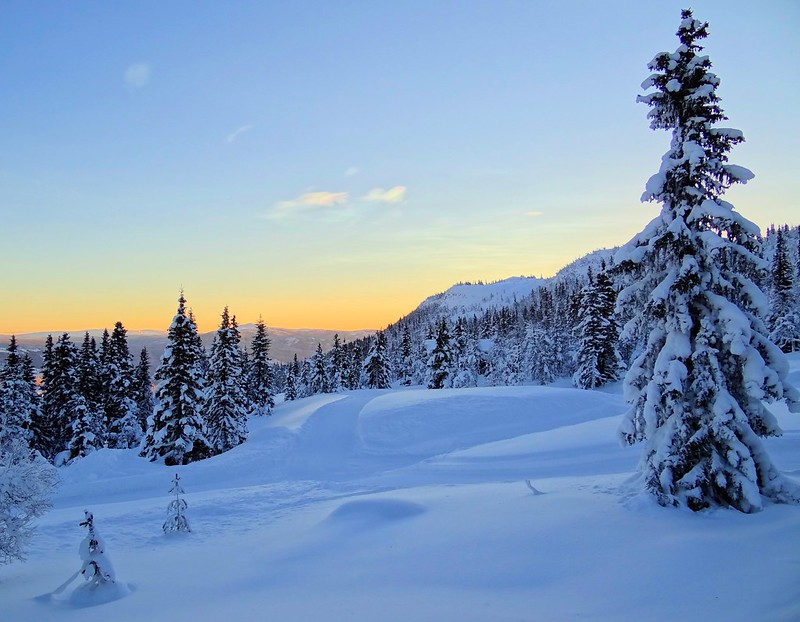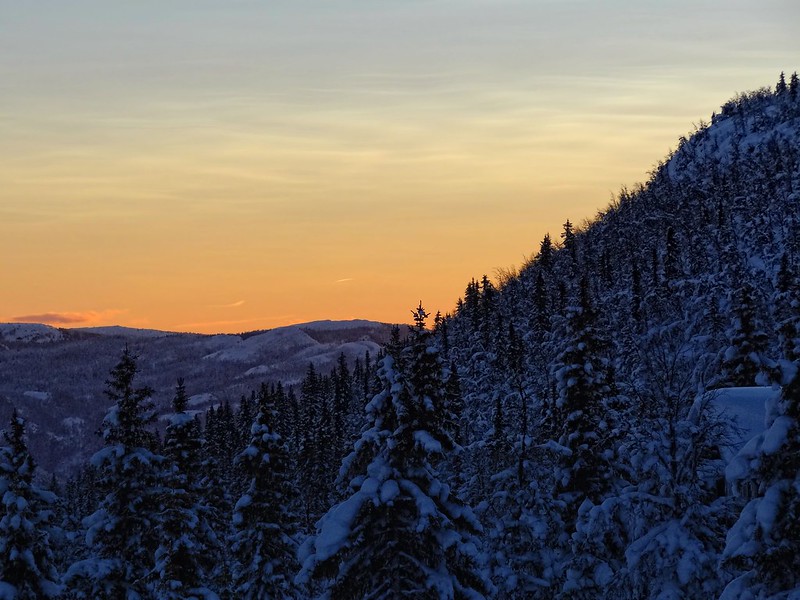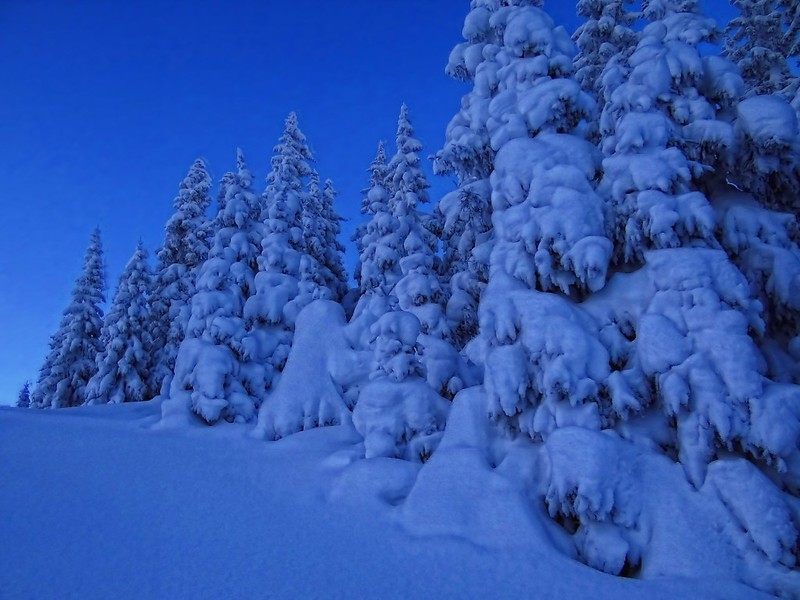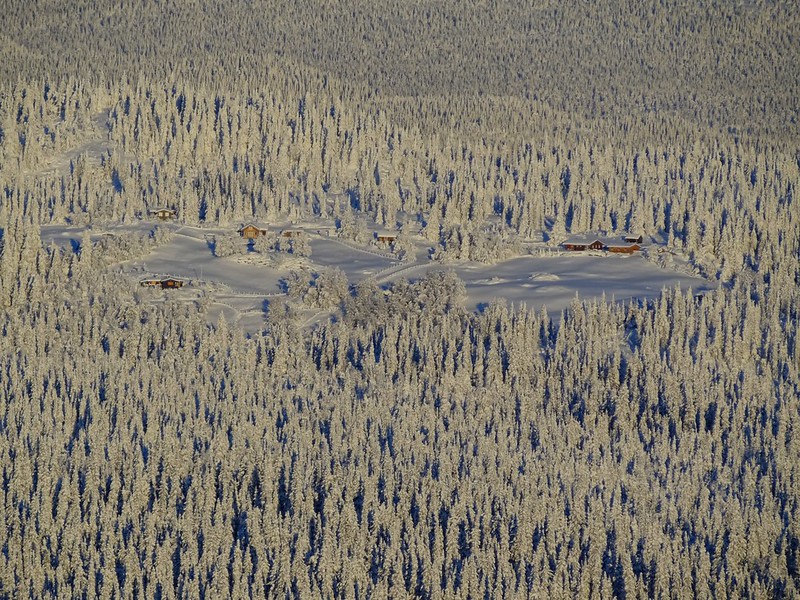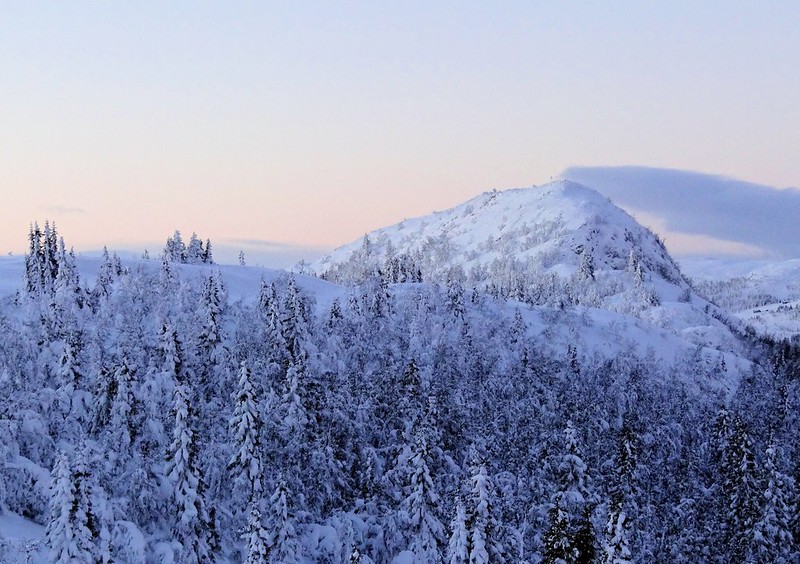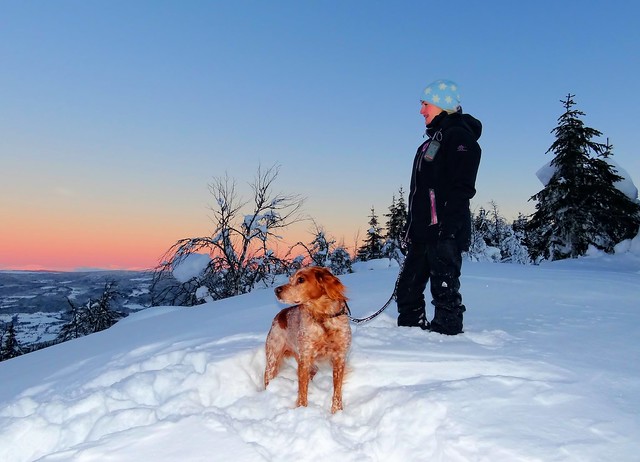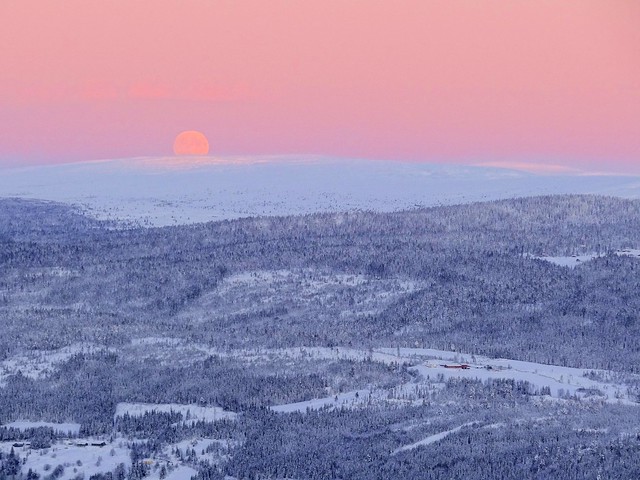Sunday, December 30, 2012
Scenes from another Christmas
This year I tried something new, spending Christmas in Southern Norway, as opposed to Northern Norway or being somewhere warm, traveling. It wasn't bad at all, and because I brought my camera, I can show you what it was like.
We begin early on Christmas Eve in Nannestad, just outside Oslo. We're heading into the woods to hide a mailbox with some silly plastic toys inside. Don't ask why. It's been snowing all through the night, so it makes for a tiresome walk, but also for an enchanting view all around us.
Fortunately someone has been kind enough to plow ski tracks through the snow, where we can walk with relative ease a bit of the way.
Back from our mailbox voyage, Christmas officially starts as we eat the traditional Norwegian Christmas dinner, ribs. (Yes, there are vegetables to eat as well, but this meal is all about the meat!)
After opening our Christmas presents we head for Kvitfjell, north of Lillehammer. Rumour has it that there are more presents to be collected there! Of course, first we have to find our cabin... Easier said than done in these mountains.
Hooray! The rumours were correct! Inside the cabin we find a fireplace, a guardian dog and a Christmas tree with presents beneath it.
This year Christmas coincides with a full moon and nice weather. The nights are bright, and we can easily go for a walk in the forest at night, even without torches.
When the sun rises in Norway in December, it only does so slowly. Also, it's only those parts of the landscape that benefit from the colouring of a low-hanging sun. To make up for that, those parts get the loveliest shade of red that any sunlight can produce. It becomes the mountains of Rondane perfectly.
"Our" side of the moutains has to go for three weeks mid-winter with no direct sun at all. It makes the world bluish, but the colours from behind the hill can not be kept from us.
The more we zoom in on the photo above, the more colour we get.
It turns out that you can create amazing scenery using just the colours of white and blue. Nature has done a good job of it here, methinks.
If Disney were to do a remake of the photo above, I think it would look something like this:
Up at the plateau near the top of Kvitfjell, the winds of the mountain have suddenly turned this into a clouded world. This makes it hard to see much apart from the whiteness of the mountains.
The wind changes its mind and soon it's clear again. We look north towards some cabins on the other side of the valley. It's easy to see why they're wooden houses.
This view promises us that in just a couple of weeks we shall again receive the gift of sunlight even on this side of the mountain.
If this was a photo from an old fairy tale, I'm pretty sure that this would either be a troll turned into a rock, or a place with trolls living inside it. The peak is called Hestknappen, "The Horse Button". Sometimes the name of a place doesn't make much sense.
We take the dog for a walk to see the sunset. At first he's jumping around, delighted to be outside. After a few minutes of slow progress through deep snow, two pleading eyes make us turn our noses and snout back to the fireplace. But the view we enjoy can not be complained about.
This is what we saw to the north from the ridge of Kvitfjell:
As the sun sets to the west, a red moon rises to the east, somewhere behind the Rondane mountains. It's our last glimpse of the Christmas of 2012.
I hope you had a nice holiday as well! #8D)
Saturday, December 15, 2012
To Fidenza and Beyond - Walking the Via Francigena
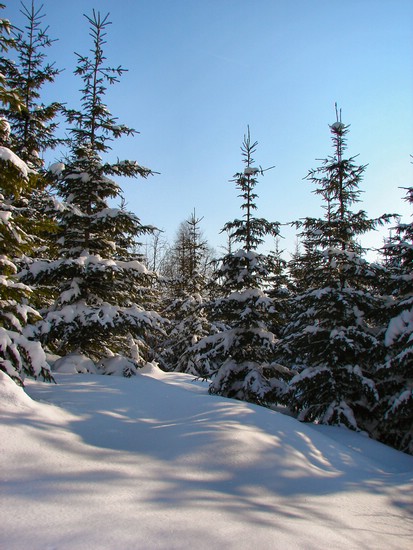 |
| Scenes like this only come with severe cold. |
A couple of years ago, I walked the Camino de Santiago de Compostela. It was a wonderful experience. It taught me how much walking I am actually capable of, which turned out to be a lot, and through my walk I felt that I almost became part of northern Spain and its hundreds of years of pilgrimage history.
I rarely visit the same place twice, if I can help it, but I confess to having thought about doing another walk to Santiago, preferably via one of the other old pilgrimage routes that end up there. Still, that would be fairly similar to my first walk, so I decided to look elsewhere for my next long walk.
The next obvious option was to walk to Rome and the Holy See. As it happens, there is an old pilgrimage trail leading there, the Via Francigena. It starts in Canterbury in England and after a long swim or boat ride it takes you through France, Switzerland and Italy. It sounds like an excellent alternative to anything Santiago, but I had never actually met someone who knew much about it, and absolutely no one who had walked it. That's usually a good reason for me to go somewhere and do it.
 |
| Click map to go to interactive version. |
I found a cheap flight to Milan and got on the first train south the next morning. It's a great start. Milano is busy, a grey and boring city for anyone not that interested in fashion. As you're about to go for a long walk, you'll probably be rather underdressed for this city, so you'll feel relieved when the train rolls out of the crazy huge Milano Centrale station.
An hour and a half later, I walked off the train in a small and cozy village in Parma. The town square was full of smiling, nicely rounded people, presumably all too familiar with parmesan cheese and Parma ham, enjoying ice cream and coffee on a hot early summer day. It was a great place to begin a walk.
I got my pilgrim's passport, my credenziali, quickly sorted at Casa Cremonini, right next to the cathedral. I acted as clueless as I could, since it was fairly clear that so were they. Granted, it was easier for me, because my Italian is really bad, but still... I expected them to be a little bit like the people who help pilgrims get started in Saint Jean Pied-de-Port for the Camino de Santiago. They aren't.
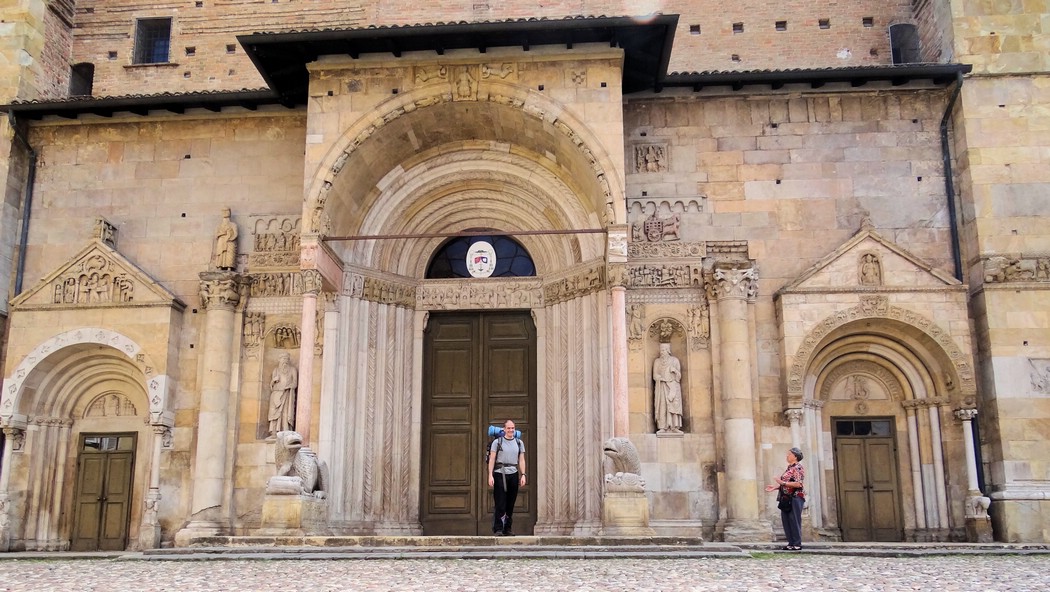 |
| An old lady witnessed me departing on my walk and decided to applaud it. |
And it wasn't! It took me two minutes to realize that compared with Camino de Santiago's friendly yellow arrows pointing out which way to go and not to go at every possible and impossible turn, often even on straight roads with deep ditches on each side, Via Francigena has little or nothing to help you.
I got lost four times before I even left the town of Fidenza. The only way to keep on track was to rely on the GPS trail I had bought from a money-minded pilgrim before leaving home. Do not leave home to walk Via Francigena without something like that to guide you. The good news is that if you start your walk from Fidenza or further south, you can just download my trail for free. I'd venture to say that my track is even better than the one I bought, as I found many places where the trail had been moved and/or where I could walk more safely, a bit away from the roads where insane Italian drivers seek out people to mow down.
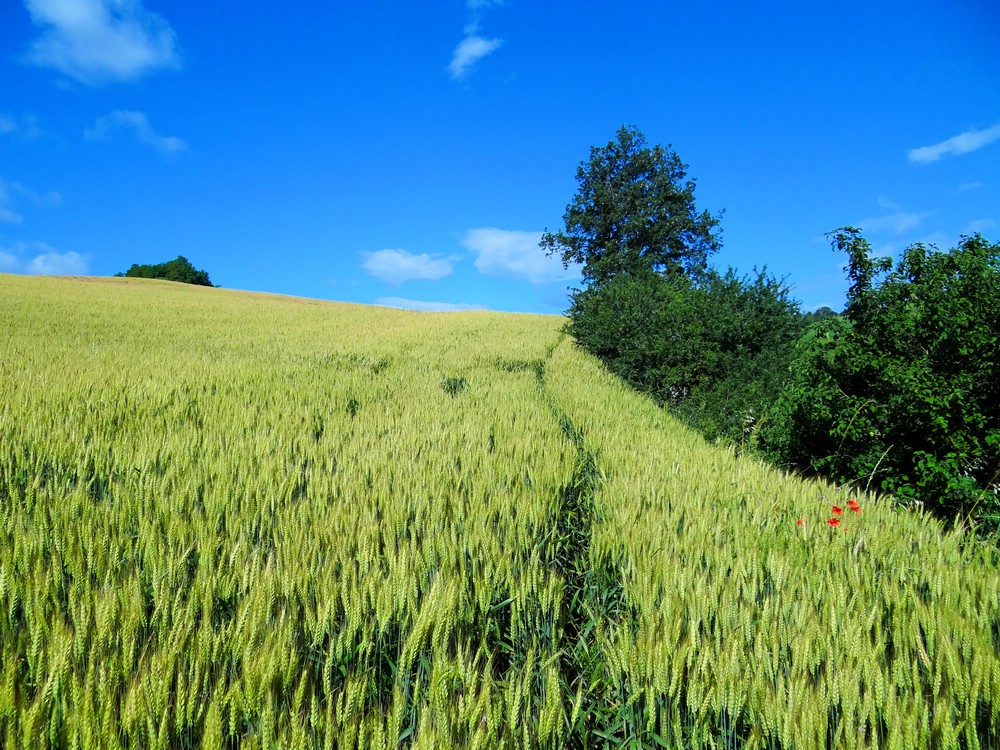 |
| That narrow line in the field, that's Via Francigena. I'm not joking. |
Today the Via Francigena is a strange labyrinth through and around an infinite number of fields and farms separating you and Rome. The detours you're sent out on are frustratingly many. My first (half) day of walking took me from Fidenza to Medesano. As the crow flies, that is 13.5 kilometres. If you drive, it's 18 kilometres. My walk was... 26 kilometres! (Not including the bits where I got lost.) It's not as bad as that every day, but it feels like it. Especially when it's 40+ degrees out.
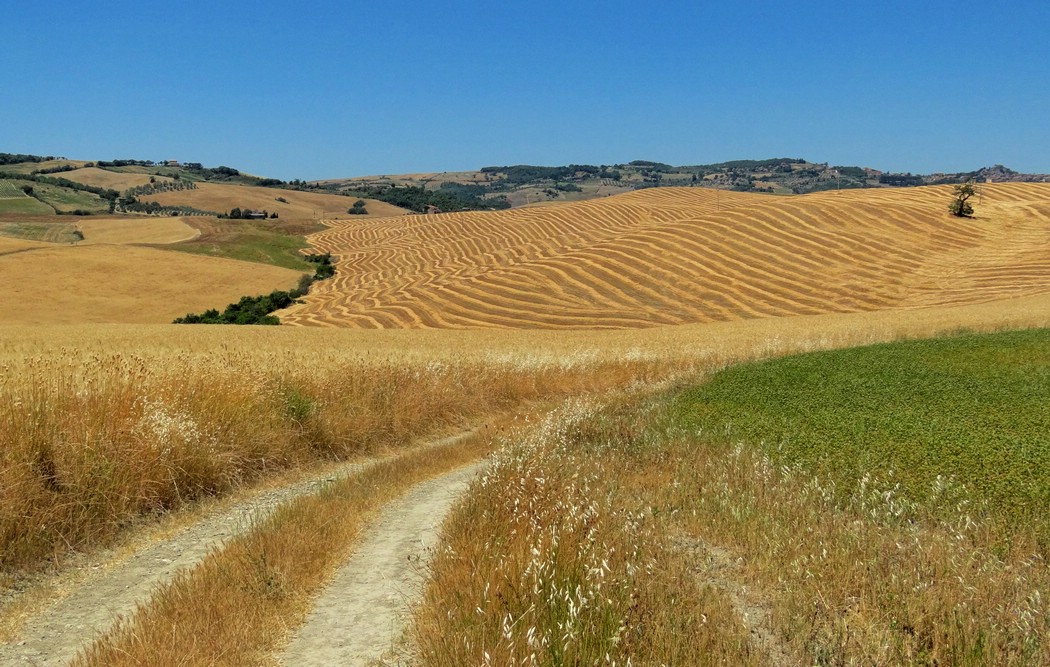 |
| Fields south of Siena, near San Quirico D'Orcia. |
So, with there being close to no pilgrims on the trail, there aren't many places for pilgrims to sleep either. Some towns have a hostel for pilgrims, most don't. If there is a place, and if you have the address, you'll often find that it's closed, and that there is no one around that knows anything about it. While there are a few amazing exceptions to the rule, most nights you will have to sleep either for free in the woods with no facilities at all, or you treat yourself to a hotel with more facilities than you care for, at a price much higher than you have budgeted for. The 10-20 euro level of great pilgrim's hostels typically available with a few kilometres between them along the Camino de Santiago are just about nowhere to be found in Italy.
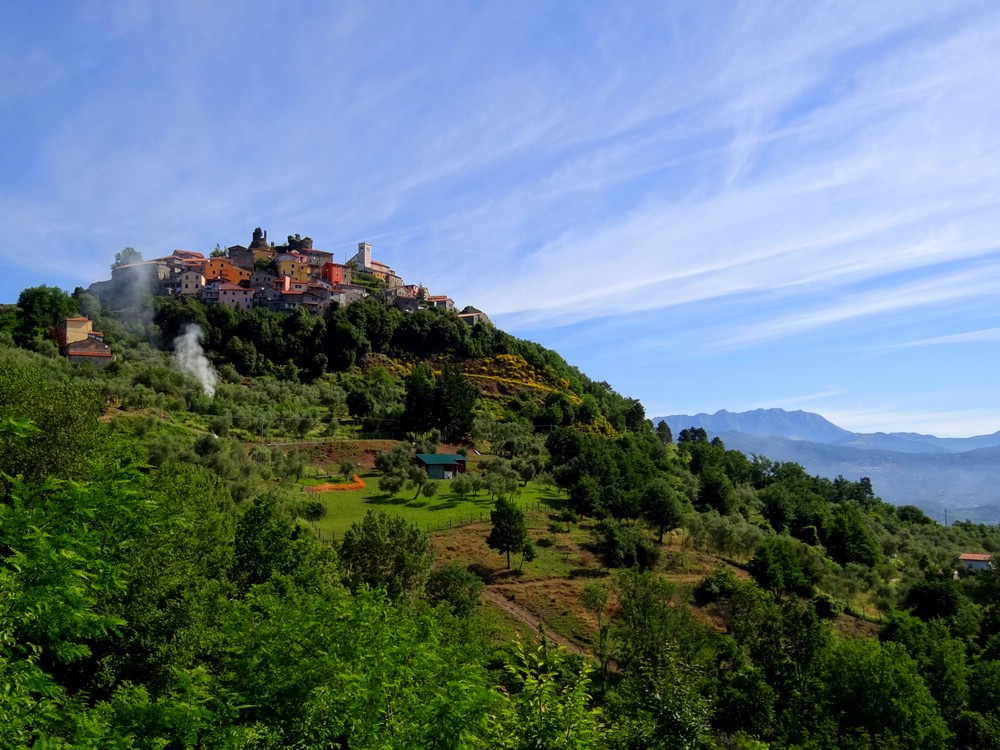 |
| Bibola was a long time ago put up on a hill to avoid plunderers and malaria. |
- The late night pizza place in Medesano.
- The medieval hamlet of Castello di Casola with the dramatic valley backdrop.
- Crossing the Appennines at the Passo della Cisa.
- Ice cream in Villafranca In Lunigiana.
- Bibola! Oh, Bibola, the most photogenic village imaginable.
- Observing rich Italians, obscenely tanned and even more obscenely dressed, enjoying themselves in Pietrasanta's night clubs and discos.
- The names of famous vines suddenly appearing as vineyards next to the path.
- Lush farmland.
- Enchanting old Viterbo, beautifully falling down.
- A most wonderful amble through a narrow strip of old forest before Sutri.
- Walking through the old and badly maintained park on Monte Mario, and suddenly have Saint Peter's Basilica visually scream at you.
Via Francigena in its current condition can never be recommended ahead of the Camino de Santiago. It's missing the facilities. It's missing the fellowshop on the trail. It's missing the bargain prices for food and lodging. It's plain out dangerous, offering way too intimate encounters with ferocious dogs and mindless drivers.
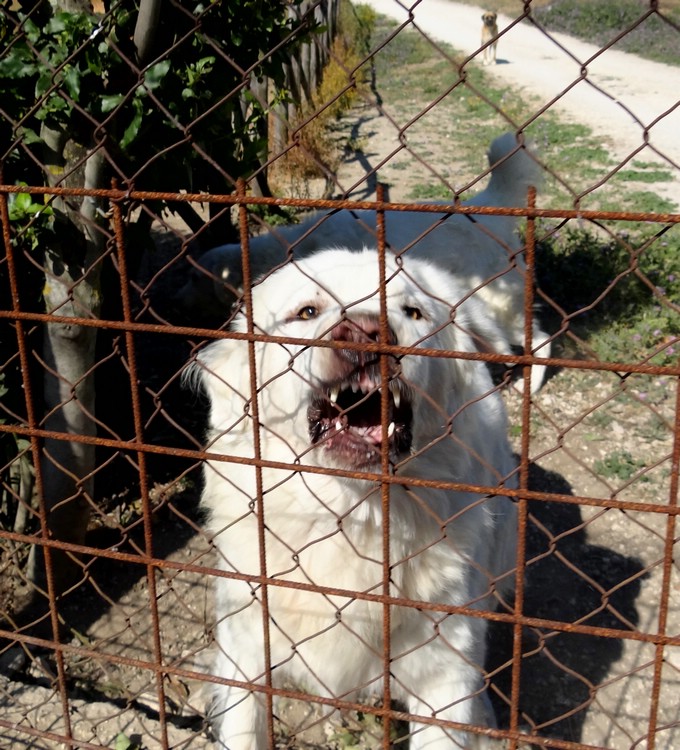 |
| Annoying dog. I like his pal in the back much better. |
My favourite parts were these walking days:
- From Fidenza to Medesano. Beautiful farmland.
- From Cassio to Berceto and across the Appennines to Pontremoli. Nice mountains.
- From Aulla to Sarzana, especially the first bit, including passing Bibola.
- From Gambassi Terme to San Gimignano. Pleasant Tuscany farmland.
- From San Quirico D'Orcia to Radicofani. The entire day is full of wonderful scenery.
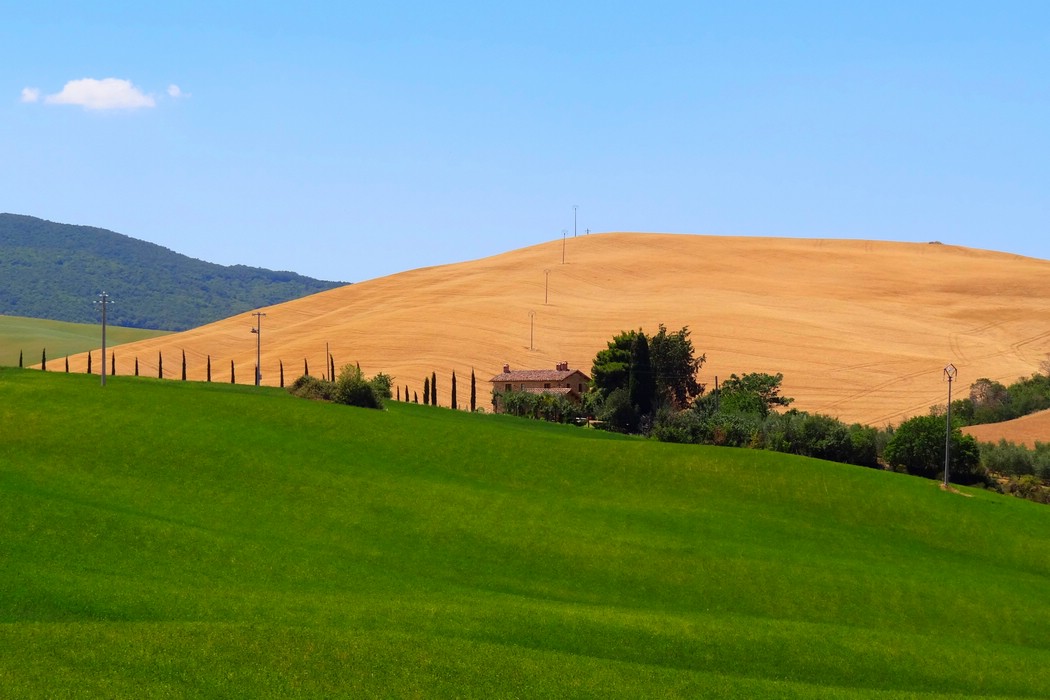 |
| I saw a lot of this. |
- The pilgrim hostel in Cassio. It's probably closed, but go to the bar up the road, they'll summon the keymaster for you.
- The pilgrim hostel in Radicofani. Just like the Camino de Santiago ones, with volunteers and all.
- Pieve di Santa Maria Assunta a Chianni, just before Gambassi Terme. Nicely restored lodging in the back, and they're open.
- Bed & Breakfast Monticelli, just after Capranica. Very friendly people despite being only option.
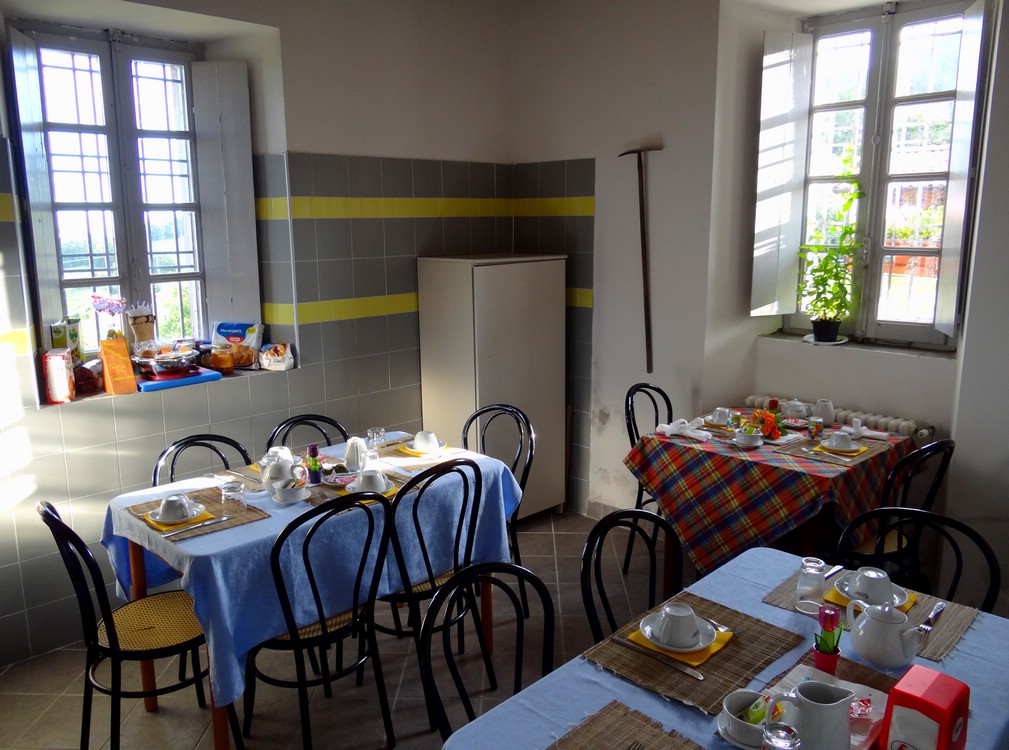 |
| I was the only one there, but the hostel in Cassio still served breakfast for me and my imaginary friends. |
So there you have it. You can find more of my photos from the walk here. If you think I'm wrong about anything at all, do not hesitate to inform me. Also, if there's anything else you'd like to know, just ask in the comments!
Happy trails!
Tuesday, December 11, 2012
Still bagging them!
As we head towards the end of another year, I am pleased to note that once again has it grown, my pile of travel sickness bags. I began collecting them back when, and I put the collection on-line in 1994. Now I have well over 200 different species, so there's no reason for me to panic if I feel a bit queasy.
I still do my best to frequently end up in a seat where I can add to my collection, but I'm also greatly assisted by my traveling friends, often turning up in unexpected places where interesting creations are located in the seat in front of them.
Here are some of my fairly recent favourites:
 | |||||||
| Some of my precious... |
Here are some of my fairly recent favourites:
- A "Hill Sickness Bag" from Indian Himalaya. The curves on the road up from Chandigarh to the hill station Shimla are many and violent. I do recommend going on the train instead. The bends are only marginally less dramatic, but the velocity is lower. Also, there's a much smaller chance of your vehicle ending up flying down off a cliff. But if travel sickness bags is your thing, going by bus is the only way.
- The air sickness bag from Yeti Airlines in Nepal. Just the name of the airline is good enough reason to love it, but if you turn the bag around, you'll find a sari-clad tikka-wearing woman in the process of demonstrating how to use a barfbag. "Kindly use this air sickness bag in case of
vomitting during flight. Thanks!" No subtleties, it's just the way we like it!
- A personal travel sickness bags from a kit with stuff you need when you travel by plane; thick, wooly socks, an eye cover, ear buds and a travel sickness bag neatly packed into a small envelope. "If an upset stomach is anticipated, remove SIC-SAC from this container and keep ready for use. Do not be embarrassed by this precaution as even veteran air travelers are subject to occasional motion sickness". This can be ordered in large numbers from the Allied Aviation Supplies Co.,
Box 75013 Farley Station, Oklahoma City, Oklahoma 73147, USA.
- AeroGal, which isn't quite as sexy as it may sound, but just the airline of the Galapagos islands. They have a marine iguana in their logo and call themselves "the intelligent airline". It's so tiny and cute that I had to put it on this list.
- Iran Aseman Airlines. It may or may not be pronounced Assman, but it's funny in other ways as well. They still operate using the Boeing 727-200, an airplane model manufactured from 1963 to 1984. Since Iranian companies are not allowed by the USA to buy new American planes, they just have to keep their old things flying. Barfbags from this company may quickly become rather difficult to find.
Saturday, December 8, 2012
Review: Rift Valley Explorer group tour by Exodus - WYJ
Please note that the following is pretty much a review of an organized tour I went on, and not the kind of blog posting I usually bring. While I try to keep it entertaining and interesting, it's probably of most interest to those of you planning on going on a safari in East Africa.
The tour was called "East Africa Safari" with tour code AQW when I participated on it. Following the publication of this review, the tour was renamed "Rift Valley Explorer" with tour code WYJ, but it is the exact same tour.
My photos from the trip.
GPS trail for the East Africa Safari
--
East Africa had long been a large, gaping hole on my travel CV. For no particular reason, really.
I usually pick my destinations through whichever flight or deal is the best whenever I have a month of free time to kill. The countries of East Africa are very poor. Kenya is number 152 and Tanzania is number 158 out of 180 on the World Bank's list of purchasing power per capita. A Norwegian has 30-35 times the purchasing power of an East African. Still, being a secure tourist in those countries can be very expensive, so going there had just never been the most attractive option.
This time, however, my time off coincided with the best time for going to East Africa. In August and September you can watch The Great Migration, basically hundreds of thousands of animals walking more or less together from Tanzania to Kenya in search of fresh grass. It's spectacular, and I wanted to see it.
You have to think in a special way when going to East Africa. Reading the web sites of hotels, you soon discover that they do not emphasize their swimming pools or their proximity to the city centre. Instead, they proudly present their high security level and tall walls with barbed-wire on top, preferably far away from where locals may roam. Getting around by local transportation can be an adventure, but more than elsewhere you must be prepared for long waits and the possibility of your trip ending up in a coffin.
Given this, and the fact that East Africa can offer some of the greatest wildlife experiences on the planet, it's not surprising that a huge number of tour companies have popped up to offer their services in the region.
Many options are undeniably very expensive. Others seem to be only a little bit expensive. It can be done independently, but I had company and we were on a fairly tight schedule, so we decided to join a tour that fit our dates, the 1,750 Euro, almost two-week East Africa Safari by Exodus. We figured there is just no way anyone can completely mess up experiencing wildlife on the scale of The Great Migration.
Here's how it went...
Having spent a few days on a farm outside Nairobi, enjoying the chance to walk around freely in the wild with little chance of encountering man-eaters or man-tramplers, we were picked up from a posh hotel in the city a couple of hours late. We were delayed because about half our group came straight off a flight that was late from England. Taking people away from their afternoon tea in London and putting them straight onto a safari in Africa is pretty crazy on its own, but I guess it's good for people who are REALLY strapped for time. To us it just meant that our day would be really busy. Regaining two lost hours is nearly impossible on the tight schedule Exodus runs.
The trip started out the worst way possible. After half an hour in Nairobi rush hour traffic (it's a fairly permanent thing), the truck stopped at a Bonjour petrol station, and our tour leader, Julius Leteele, told us that now would be a good time to stock up on snacks and water. So we did.
The whole thing felt like an ambush. The groups was defenseless, most being very tired and having just gotten off a plane and changed money into a new currency of unfamiliar value. The guys at the register effortlessly scammed us. No one watched our pale and bony European asses. "One bottle of water and a packet of biscuits? That's... Let's see... Two thousand schillings!" No receipts were given, but most of us paid well above what we would have paid for similar items back in Europe. By the time we left the shop, the two clerks had made a fortune and probably got on the phone straight away to buy themselves new mansions in the highlands where they could now go and live happily ever after.
We continued the drive into the Great Rift Valley and set up camp by Lake Naivasha, at Crayfish Camp. Julius taught us how to pitch our tents without poking out too many eyeballs, and then we were off to the only bit of walking safari on this trip. It was nice enough visit to a forest near Crater Lake, although it hardly classified as a walk on the wild side. Still, we saw lots of antilope, some buffaloes and a good-sized group of giraffes. It was a pleasant and gentle introduction to African wildlife for anyone new to it.
It was dark before we were back at the camp, stopping off at the shore of the lake for two minutes to barely make out the shape of a hippo head or two in the dark water. The cook had done his best to prepare food catering to a British sense of taste. Unfortunately, he was quite good at it, so we had to suffer through proper, old-fashioned English cuisine for the rest of the trip.
On the morning of day 2 I braved the really cold air and enjoyed a quick, hot and rustic shower, before we had a long English Breakfast and got on the road. Three hours in the truck, a change to Land Cruisers in Narok and then another two hours on a fairly bumpy road brought us to the Sekenani gate of the Maasai Mara National Reserve.
We were to spend two nights at the Mountain Rock Mara Springs Camp, where we had the most comfortable time of the entire journey. Instead of pitching our tents again, we slept in a "permanent camp", house-like tents with en-suite bathroom. There was an afternoon game drive of 3,5 hours and a good meal. We didn't bring a cook here, so it was NOT British style, hooray! Day 3 was spent on an excellent ten hour game drive conducted by a professional local guide, taking us through the park all the way to the Tanzanian border and the river Mara and back.
Day 4 wasn't too exciting, as all we did was to backtrack to Lake Naivasha and then continue to Lake Nakuru, altogether 340 kilometres of road watching. Little or no information was given about anything we saw on our way, so I'm not sure if there was something I should have noticed. Upon arrival we were offered a "farm walk", which turned out to be a worker showing us a field of cows and an old barn. A workers collective, Kenana Knitters is based there, but they had all left work for the day by the time we made it there.
Day 5 was another full day game drive (5,5 hours), but this time we were unfortunately doing it in our truck, and we didn't enter the park until around nine o'clock, when the sun was high in the sky and most animals had retreated to the shade deep in the bush. Through what must have been some divine intervention, we still managed to find three lions in a tree right away. The rest of it was also okay, although our guide kept falling asleep, and the one rhino I managed to spot turned out to be a rock. Just as well, really. As it turned out, due to a break in the time/space continuum, it could take up to a full minute from the moment we shouted out for the truck to stop for some animal watching until the message would actually reach our driver. If there still was something to see outside our truck by then, it was sheer luck.
Day 6, probably the least interesting day of the trip, was a 416 kilometer drive through western Kenya into Tanzania. It was a straight-through thing with no stopping to pay the glorious landscape of the tea plantations along the road. Why not? Because visits to tea plantations must be booked a month in advance, according to our guide. I suppose that's how long it takes for a Kenyan tea plantation to clean up the scene enough to give the impression that it looks like a decent place to work. I don't see why Exodus couldn't have booked a visit, though. Most of the people on the bus had booked their trip several months ago. Especially since the brochure puts it this way: "Our long drive today allows plenty of time to appreciate the superb scenery". Right, just not while being stationary.
So we just kept on driving and driving. The bladders of everyone onboard performed well, so there were no catastrophes. Apparently, in Kenya one is only allowed to take pee breaks at insanely overpriced curio shops which take a long time to find.
Having read and heard so much about it, I was really looking forward to seeing Lake Victoria. I was a bit disappointed to discover that we would only actually see it for about half an hour, as we arrived just before sunset. The next morning we were not going for a game drive at all, so all of a sudden it was important that we got up before sunrise to get back on the road. The only ones who were up before us this day were the mosquitoes. Lots of mosquitoes.
Day 7 was another long drive, but this one was better than the previous day. We spent much of the day driving through the Serengeti National Park, and there were many animals around. The highlight was camping at a most basic, unfenced site in the middle of the park, where we could listen to the magical sounds of the nocturnal animals busy at work. Except our guide kept warning us about the dangers of wild animals, to the degree that half the group didn't dare go to sleep inside their tents, and instead spent the night drinking wine and keeping the noise level so high that all animals kept a good and safe distance to our camp.
The beginning of Day 8 was okay, as we went on a morning game drive. It was a LATE morning game drive, because before we could go to see the animals in one of the most amazing wilderness parks in the world, we had to spend more than an hour having breakfast and pulling down our camp. We shared the camp with another group who left their tents to be taken down later and immediately got out on their drive before sunrise, and that made it feel particularly wrong doing chores in the dawn and feasting on another horrible English breakfast instead of being out there with the animals.
So, our time in Serengeti was effectively limited to a three hour morning drive. Fortunately we were heading for even greater things. A ferocious rainstorm set in, and our driver decided to push through it as quickly as possible.
The road disagreed, and did its bumpiest. For four hours we speedily pushed through towards the rim of the Ngorongoro crater, our truck falling more and more apart all the time. Windows started liberating themselves from the rest of the vehicle and new and exciting metallic sounds began to dominate the soundscape inside the vehicle. Nothing could stop us! Not yet, anyway.
Again we arrived at the campsite just as darkness fell, so we never got to see the glorious view of the Ngorongoro Crater at sunset from the rim. Instead, we again pitched our tents, had semi-warm showers and watched or helped Anglofood being prepared from unspeakable ingredients.
Day 9 was an excellent day again. We ditched our truck, driver and guide, and got a real safari instead, seated in Land Cruisers. The hours at the Ngorongoro Crater were stunning, starting as we descended through dense fog and mist hanging on the rim, to an increasingly sunny plateau inside the crater. The place is truly like a lost world, where both the innocence and the brutality of Nature herself keeps coming right at you from all angles.
Clearly, Exodus had only paid for the half-day thing, so we were rushed out of the crater just in time for the twelve o'clock deadline. Our truck had been fixed with duct tape and string, so we picked it up again and started driving towards Arusha. On our way we passed Lake Manyara, described in the tour itinerary this way: "We continue our journey through beautiful country, where there is a great view over Lake Manyara, often tinted pink around the edges from large numbers of flamingos". We enjoyed that view for a full half second in a sharp bend on the road through the windows of the truck. I can't say I treasure that memory.
We stopped at the Maserani Snake Park Camping for the night. It's a safe place with no locals at all around. The exception is a rather sad-looking display of fairly local live snakes, birds and monkeys. The showers there were hot, or at least offered a rich experience of electrical shocks.
Day 10 was spent getting back to Kenya, to get to the last national park on our trip; Amboseli. Our truck broke down completely, still upset from the battering it had received in the Serengeti a couple of days earlier. It was the best thing that happened that day. As we had to wait for a plan B to emerge, there was nothing sheltering us from the curious locals who could now enjoy the view of miserable foreigners. Oh, how quickly the roles can change on the scene of life! Anyway, some of us went over to them and enjoyed a couple of hours of entertaining conversation and mimics with them. Eventually a bus from the national park arrived to bring us to our camp. No safari that day.
That was okay, because the last full day of our tour was spent on a game drive in Amboseli, seeing mainly the numerous and large elephants the park is so famous for. I quite enjoyed it. I also enjoyed the camp site, although it was the most basic one on the trip. The facilities were two showers and two toilets a long walk away from where we pitched our tents. The only items for sale in the area were water and beer, sold straight from a portable non-electric cooler in a tent-like construction nearby. We received the usual safety brief telling us not to leave the immediate proximity of the camp, or else. The amusing bit was that while all other camps in the area seemed to be located behind two or three layers of tall, electrical fences, all that kept the animals away from us were thorny branches that had been gathered and piled up around us. To minimize our protection, we used those very branches as firewood throughout the evening.
Finally we spent a full day driving back to Nairobi. To be precise, we spent most of the day driving IN Nairobi. The worst bit was spending 2 hours and 45 minutes on just under 7 kilometres of insanely slow and crowded traffic. We could of course have walked it much faster, but it's likely that we would have become victims of a wide range of crimes on our way. Including all the waiting at the police station that would necessarily follow, we probably would not have saved much time.
So there you have it.
Did I have a good time in East Africa? Yes, definitely! I came for the animals, and I got lots of animals.
Was I happy with the way the Exodus conducted the trip? Not. At. All.
Upon returning to Norway, I contacted Exodus and basically asked them about the discrepancies between how they present their tours and how they actually operate them. They did respond promptly and politely, and they seemed to be honestly concerned regarding several of the issues I brought up. They were even nice enough to offer me a small compensation, "as a gesture of goodwill". (That was not my goal, I just wanted some answers, so I turned it down.)
That said, I got the feeling that their actual response is that this trip, the East Africa Safari (code AQW), is only sold as an Exodus tour, but it's actually run by a local operator who is free to conduct the tour the way they deem best. As long as choices are made to ensure that no one gets in harm's way, that is of course a good thing. However, as I have discovered, it may lead to much frustration in groups where some people are experienced travelers and others are the opposite, yet the same restrictions, cautions and schedules are applied to everyone.
If you know how to travel, you will always have a better experience on your own than on a mixed group like this. Sometimes joining a tour is still just the most practical or sometimes only way to go where you'd like to. If you pick a tour at the lower end of the price range, like the one described here, be prepared to spend much time around sunset and sunrise doing chores instead of exploring and taking photos. Going on a pricier tour will leave you with more time on your own. There's also the option of not booking ahead, but instead just go to Nairobi and Arusha and book your tour from there. You will get "better" (as in more comfortable lodging, better food and at a slower pace) tours there at the same or even lower rates than what I paid for the Exodus trip.
These are the main issues I had with the tour:
Morning procedures
Early morning is the best time for watching wildlife. You get up, you have a cup of hot tea or chocolate, and then you go out to see the animals before the sun rises and makes them go sleep in the shade. We wasted most of our mornings on eating and doing chores instead.
Safari guiding
While our guide was fairly good at identifying the animals we saw, he was not at all enthusiastic about it and only sparingly offered any information about the wildlife. As I was having exciting wildlife experiences, he managed to fall asleep and not participate in the animal spotting at all.
I can understand him being tired, he told us that he had been on another tour lasting up until the day before we started out, and the day after we were dropped off in Nairobi he was off again on a trip to Uganda. I put the blame for this on Exodus. The weariness and lack of enthusiasm from a guide can easily infect the people on the trip.
Photography
Exodus do offer special tours for photographers, but this wasn't one of them. Still, our driver and our guide were really bad at positioning the vehicle for optimal photographies. If that's important for you, you probably want to seek out a different trip.
Fear mongering regarding the animals
I've already mentioned the lack of quality information regarding the wildlife. The one thing we had more than enough of, however, were statements about how dangerous the animals are. I've been on many safaris, and I have never heard such exaggerated warnings from the tour guide about what we should absolutely not do, because then this or that animal would come and hurt or kill us.
That's just not fair on the animals.
Fear mongering regarding the people
We were repeatedly warned against the risk of thieves and stone throwers. I've traveled quite a bit in Africa, and I think I know what dangers encounters with the locals can involve, and it's nowhere near as bad as what we were told on this trip. The result? Most of the people on our tour talked only to the others on the truck. I feel they missed out. We were rarely given opportunities to interact with Africans, instead we were encouraged to stay in the camp and never leave the vicinity of the truck.
That's just not fair on the people.
Mismatch between itinerary and reality
I read the itinerary with optimistic eyes, so my hopes were crushed a few times. Most of the optional activities were just impossible to find enough time for.
Financial guiding
Exodus emphasizes that they aim to operate in a responsible manner. In my opinion, that should include informing their clients about roughly how much they should spend on various items, instead of just dropping people off into hoards of people out only to maximize money drainage from tourists. At least on this tour there was none of that. Quite the opposite happened, actually. We were invariably advised to shop at places that were much more expensive than neighbouring shops.
In the end, however, I did get to see lots of great stuff on this trip. Although I just know it could have been even better, I won't grumble more about than I have done now. Thank you for bearing with me.
I'd love to read your experience from this or similar tours, so go ahead and make your comments below!
Happy trails! #8D)
The tour was called "East Africa Safari" with tour code AQW when I participated on it. Following the publication of this review, the tour was renamed "Rift Valley Explorer" with tour code WYJ, but it is the exact same tour.
My photos from the trip.
 |
| Click map to go to zoom-able version |
--
East Africa had long been a large, gaping hole on my travel CV. For no particular reason, really.
I usually pick my destinations through whichever flight or deal is the best whenever I have a month of free time to kill. The countries of East Africa are very poor. Kenya is number 152 and Tanzania is number 158 out of 180 on the World Bank's list of purchasing power per capita. A Norwegian has 30-35 times the purchasing power of an East African. Still, being a secure tourist in those countries can be very expensive, so going there had just never been the most attractive option.
This time, however, my time off coincided with the best time for going to East Africa. In August and September you can watch The Great Migration, basically hundreds of thousands of animals walking more or less together from Tanzania to Kenya in search of fresh grass. It's spectacular, and I wanted to see it.
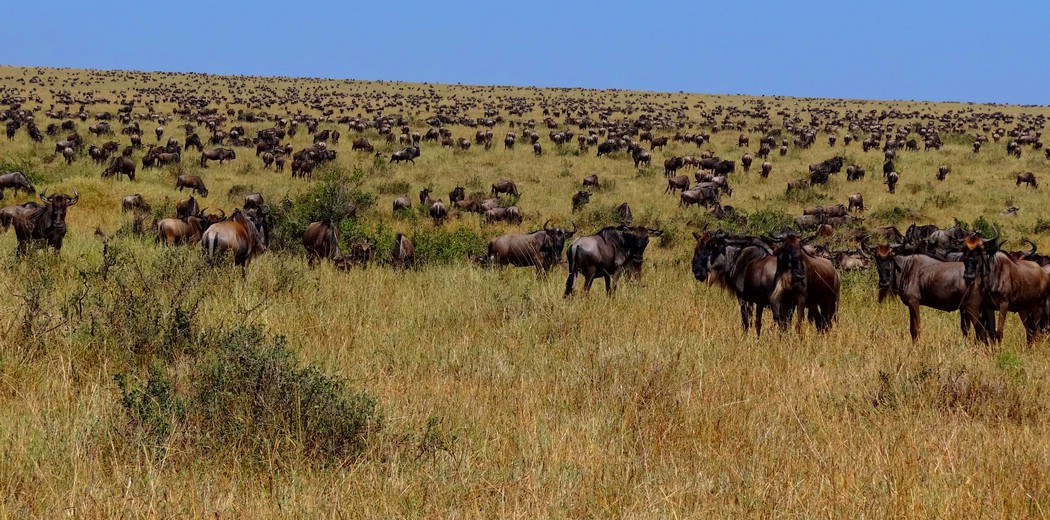 |
| The Great Crowded Migration it its peak |
You have to think in a special way when going to East Africa. Reading the web sites of hotels, you soon discover that they do not emphasize their swimming pools or their proximity to the city centre. Instead, they proudly present their high security level and tall walls with barbed-wire on top, preferably far away from where locals may roam. Getting around by local transportation can be an adventure, but more than elsewhere you must be prepared for long waits and the possibility of your trip ending up in a coffin.
Given this, and the fact that East Africa can offer some of the greatest wildlife experiences on the planet, it's not surprising that a huge number of tour companies have popped up to offer their services in the region.
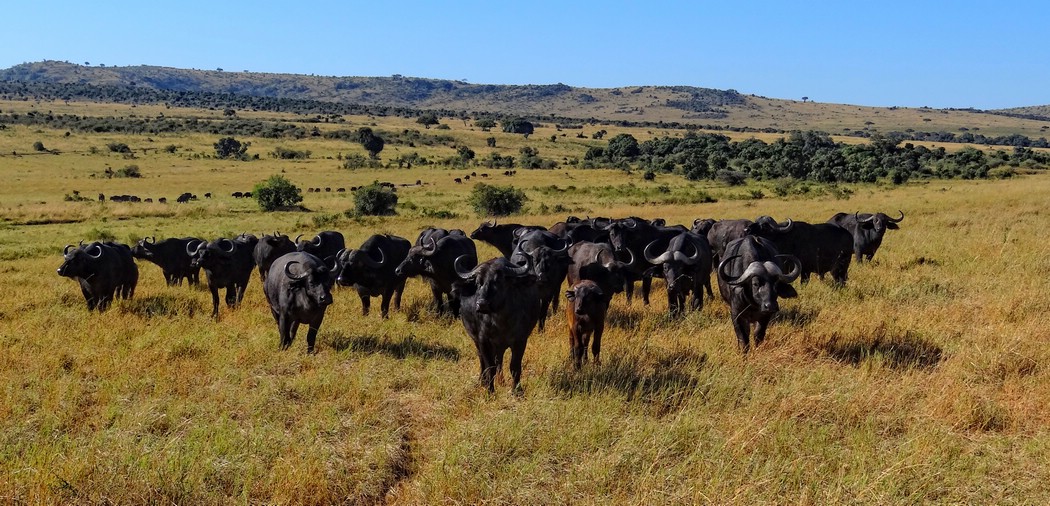 |
| Cape Buffaloes, almost as scary as going on a tour full of strangers |
Many options are undeniably very expensive. Others seem to be only a little bit expensive. It can be done independently, but I had company and we were on a fairly tight schedule, so we decided to join a tour that fit our dates, the 1,750 Euro, almost two-week East Africa Safari by Exodus. We figured there is just no way anyone can completely mess up experiencing wildlife on the scale of The Great Migration.
Here's how it went...
Once upon a time in Africa
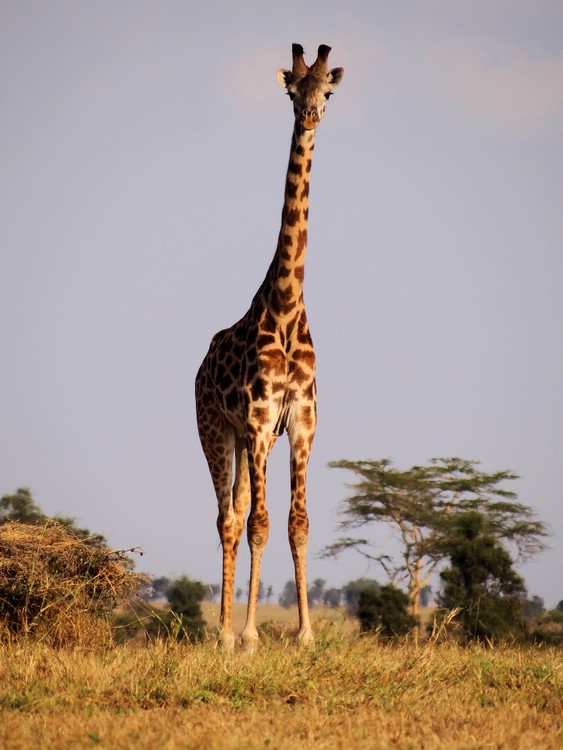 |
| Walking safari sighting |
The trip started out the worst way possible. After half an hour in Nairobi rush hour traffic (it's a fairly permanent thing), the truck stopped at a Bonjour petrol station, and our tour leader, Julius Leteele, told us that now would be a good time to stock up on snacks and water. So we did.
The whole thing felt like an ambush. The groups was defenseless, most being very tired and having just gotten off a plane and changed money into a new currency of unfamiliar value. The guys at the register effortlessly scammed us. No one watched our pale and bony European asses. "One bottle of water and a packet of biscuits? That's... Let's see... Two thousand schillings!" No receipts were given, but most of us paid well above what we would have paid for similar items back in Europe. By the time we left the shop, the two clerks had made a fortune and probably got on the phone straight away to buy themselves new mansions in the highlands where they could now go and live happily ever after.
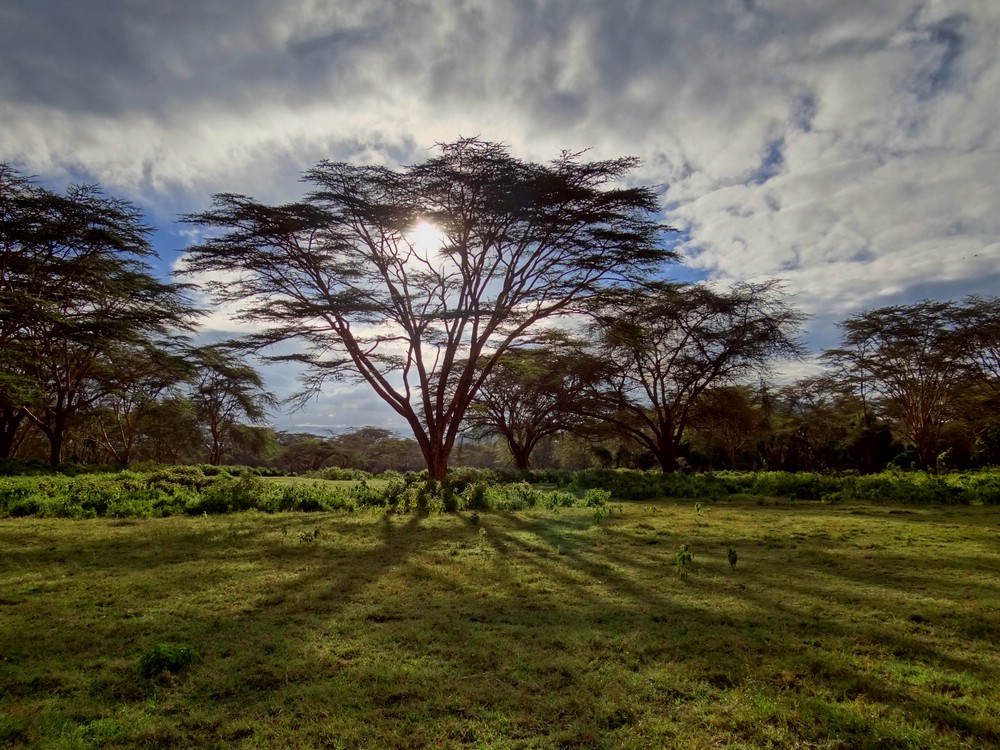 |
| Lake Naivasha forest |
We continued the drive into the Great Rift Valley and set up camp by Lake Naivasha, at Crayfish Camp. Julius taught us how to pitch our tents without poking out too many eyeballs, and then we were off to the only bit of walking safari on this trip. It was nice enough visit to a forest near Crater Lake, although it hardly classified as a walk on the wild side. Still, we saw lots of antilope, some buffaloes and a good-sized group of giraffes. It was a pleasant and gentle introduction to African wildlife for anyone new to it.
It was dark before we were back at the camp, stopping off at the shore of the lake for two minutes to barely make out the shape of a hippo head or two in the dark water. The cook had done his best to prepare food catering to a British sense of taste. Unfortunately, he was quite good at it, so we had to suffer through proper, old-fashioned English cuisine for the rest of the trip.
On the morning of day 2 I braved the really cold air and enjoyed a quick, hot and rustic shower, before we had a long English Breakfast and got on the road. Three hours in the truck, a change to Land Cruisers in Narok and then another two hours on a fairly bumpy road brought us to the Sekenani gate of the Maasai Mara National Reserve.
We were to spend two nights at the Mountain Rock Mara Springs Camp, where we had the most comfortable time of the entire journey. Instead of pitching our tents again, we slept in a "permanent camp", house-like tents with en-suite bathroom. There was an afternoon game drive of 3,5 hours and a good meal. We didn't bring a cook here, so it was NOT British style, hooray! Day 3 was spent on an excellent ten hour game drive conducted by a professional local guide, taking us through the park all the way to the Tanzanian border and the river Mara and back.
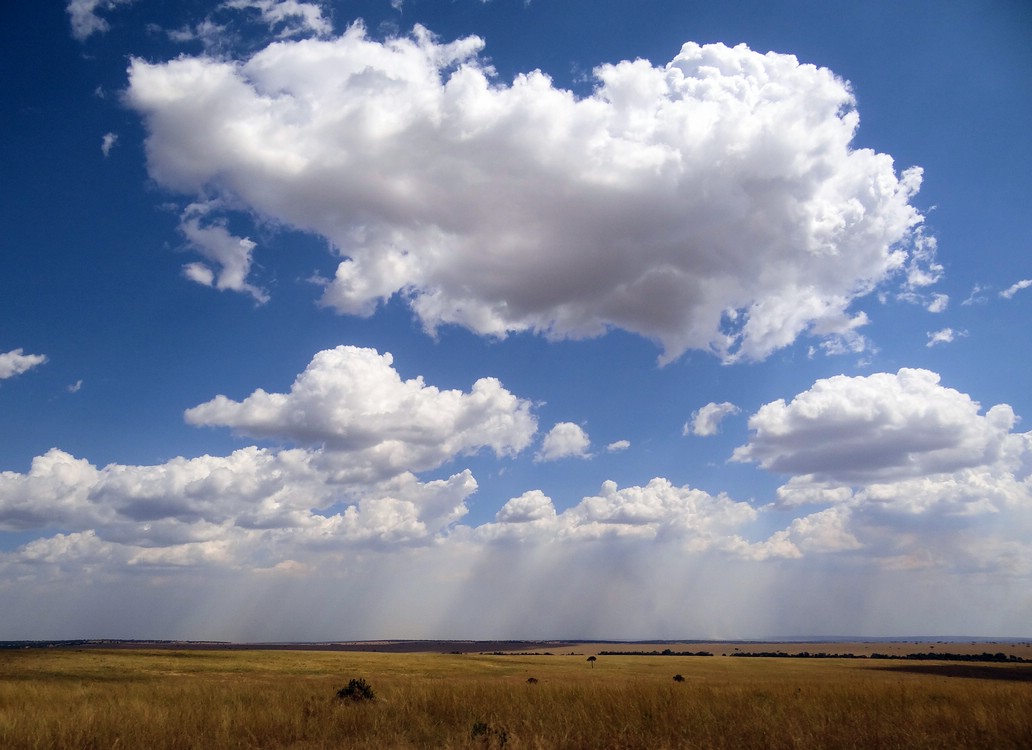 |
| Maasai Mara scenery |
Day 4 wasn't too exciting, as all we did was to backtrack to Lake Naivasha and then continue to Lake Nakuru, altogether 340 kilometres of road watching. Little or no information was given about anything we saw on our way, so I'm not sure if there was something I should have noticed. Upon arrival we were offered a "farm walk", which turned out to be a worker showing us a field of cows and an old barn. A workers collective, Kenana Knitters is based there, but they had all left work for the day by the time we made it there.
Day 5 was another full day game drive (5,5 hours), but this time we were unfortunately doing it in our truck, and we didn't enter the park until around nine o'clock, when the sun was high in the sky and most animals had retreated to the shade deep in the bush. Through what must have been some divine intervention, we still managed to find three lions in a tree right away. The rest of it was also okay, although our guide kept falling asleep, and the one rhino I managed to spot turned out to be a rock. Just as well, really. As it turned out, due to a break in the time/space continuum, it could take up to a full minute from the moment we shouted out for the truck to stop for some animal watching until the message would actually reach our driver. If there still was something to see outside our truck by then, it was sheer luck.
Day 6, probably the least interesting day of the trip, was a 416 kilometer drive through western Kenya into Tanzania. It was a straight-through thing with no stopping to pay the glorious landscape of the tea plantations along the road. Why not? Because visits to tea plantations must be booked a month in advance, according to our guide. I suppose that's how long it takes for a Kenyan tea plantation to clean up the scene enough to give the impression that it looks like a decent place to work. I don't see why Exodus couldn't have booked a visit, though. Most of the people on the bus had booked their trip several months ago. Especially since the brochure puts it this way: "Our long drive today allows plenty of time to appreciate the superb scenery". Right, just not while being stationary.
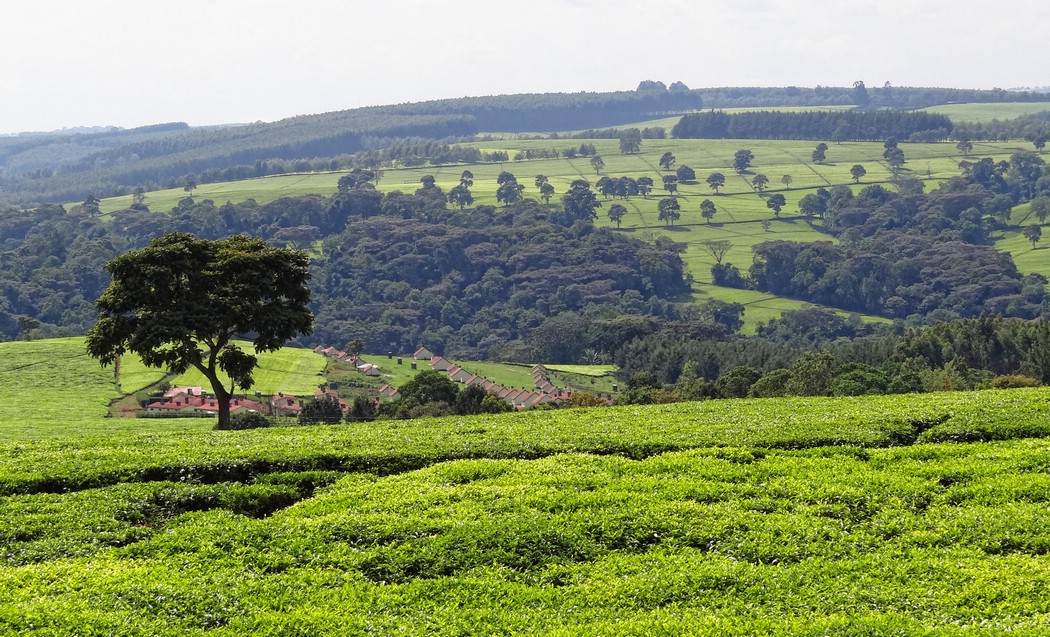 |
| Tea Country! |
So we just kept on driving and driving. The bladders of everyone onboard performed well, so there were no catastrophes. Apparently, in Kenya one is only allowed to take pee breaks at insanely overpriced curio shops which take a long time to find.
Having read and heard so much about it, I was really looking forward to seeing Lake Victoria. I was a bit disappointed to discover that we would only actually see it for about half an hour, as we arrived just before sunset. The next morning we were not going for a game drive at all, so all of a sudden it was important that we got up before sunrise to get back on the road. The only ones who were up before us this day were the mosquitoes. Lots of mosquitoes.
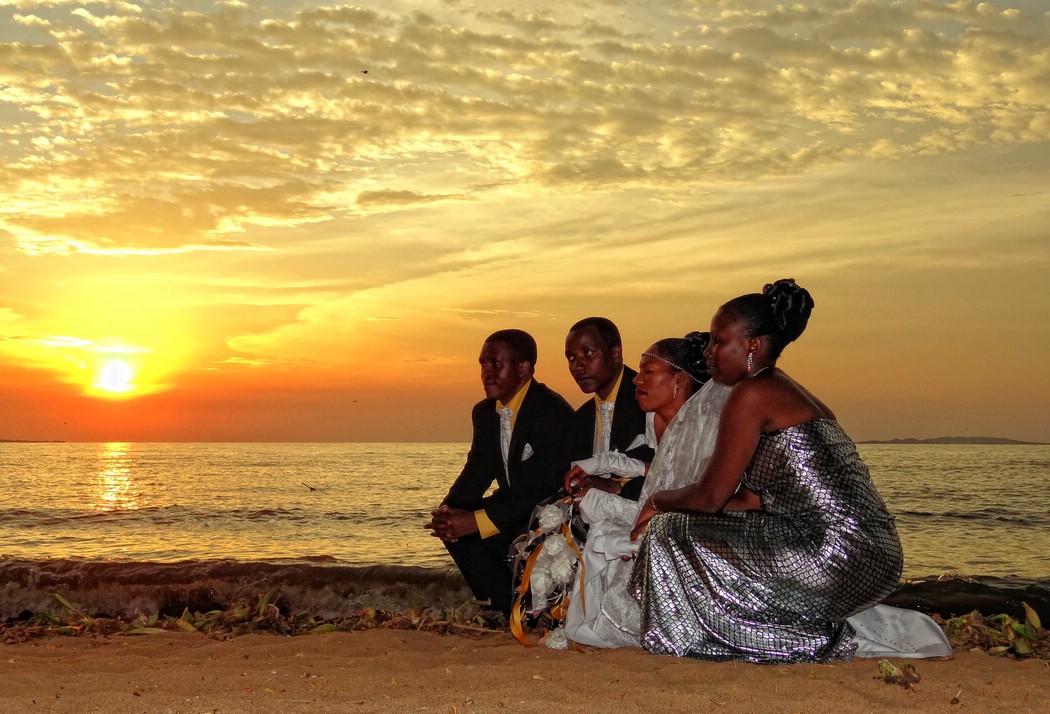 |
| I spent my time by Lake Victoria wisely, I think, sneaking into a wedding on the beach. |
Day 7 was another long drive, but this one was better than the previous day. We spent much of the day driving through the Serengeti National Park, and there were many animals around. The highlight was camping at a most basic, unfenced site in the middle of the park, where we could listen to the magical sounds of the nocturnal animals busy at work. Except our guide kept warning us about the dangers of wild animals, to the degree that half the group didn't dare go to sleep inside their tents, and instead spent the night drinking wine and keeping the noise level so high that all animals kept a good and safe distance to our camp.
The beginning of Day 8 was okay, as we went on a morning game drive. It was a LATE morning game drive, because before we could go to see the animals in one of the most amazing wilderness parks in the world, we had to spend more than an hour having breakfast and pulling down our camp. We shared the camp with another group who left their tents to be taken down later and immediately got out on their drive before sunrise, and that made it feel particularly wrong doing chores in the dawn and feasting on another horrible English breakfast instead of being out there with the animals.
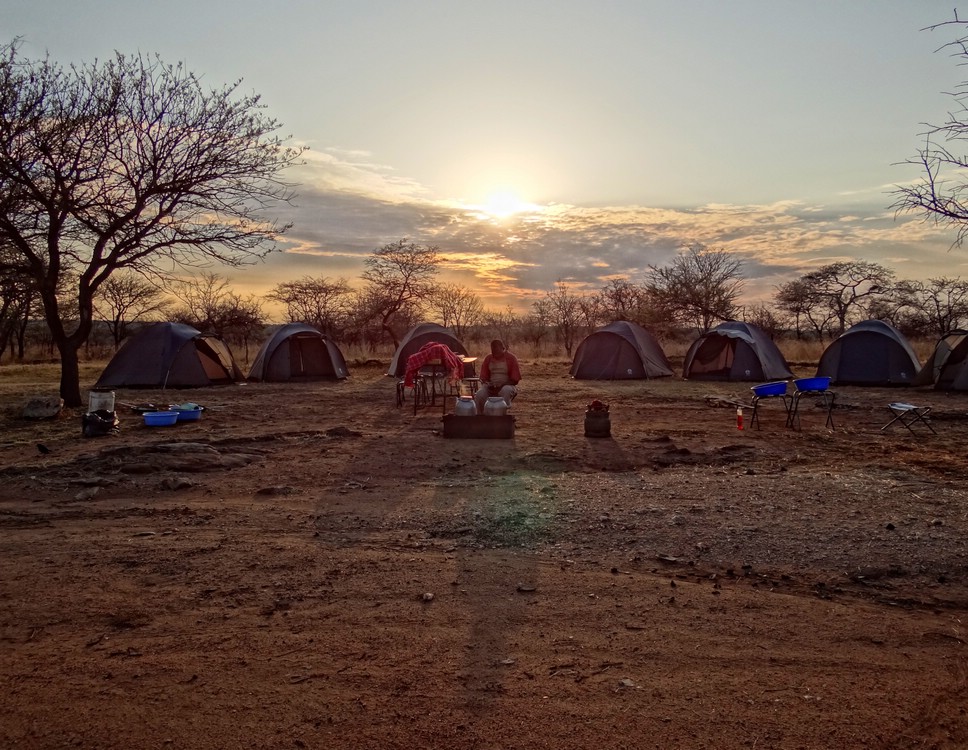 |
| The camp in Serengeti |
So, our time in Serengeti was effectively limited to a three hour morning drive. Fortunately we were heading for even greater things. A ferocious rainstorm set in, and our driver decided to push through it as quickly as possible.
The road disagreed, and did its bumpiest. For four hours we speedily pushed through towards the rim of the Ngorongoro crater, our truck falling more and more apart all the time. Windows started liberating themselves from the rest of the vehicle and new and exciting metallic sounds began to dominate the soundscape inside the vehicle. Nothing could stop us! Not yet, anyway.
Again we arrived at the campsite just as darkness fell, so we never got to see the glorious view of the Ngorongoro Crater at sunset from the rim. Instead, we again pitched our tents, had semi-warm showers and watched or helped Anglofood being prepared from unspeakable ingredients.
Day 9 was an excellent day again. We ditched our truck, driver and guide, and got a real safari instead, seated in Land Cruisers. The hours at the Ngorongoro Crater were stunning, starting as we descended through dense fog and mist hanging on the rim, to an increasingly sunny plateau inside the crater. The place is truly like a lost world, where both the innocence and the brutality of Nature herself keeps coming right at you from all angles.
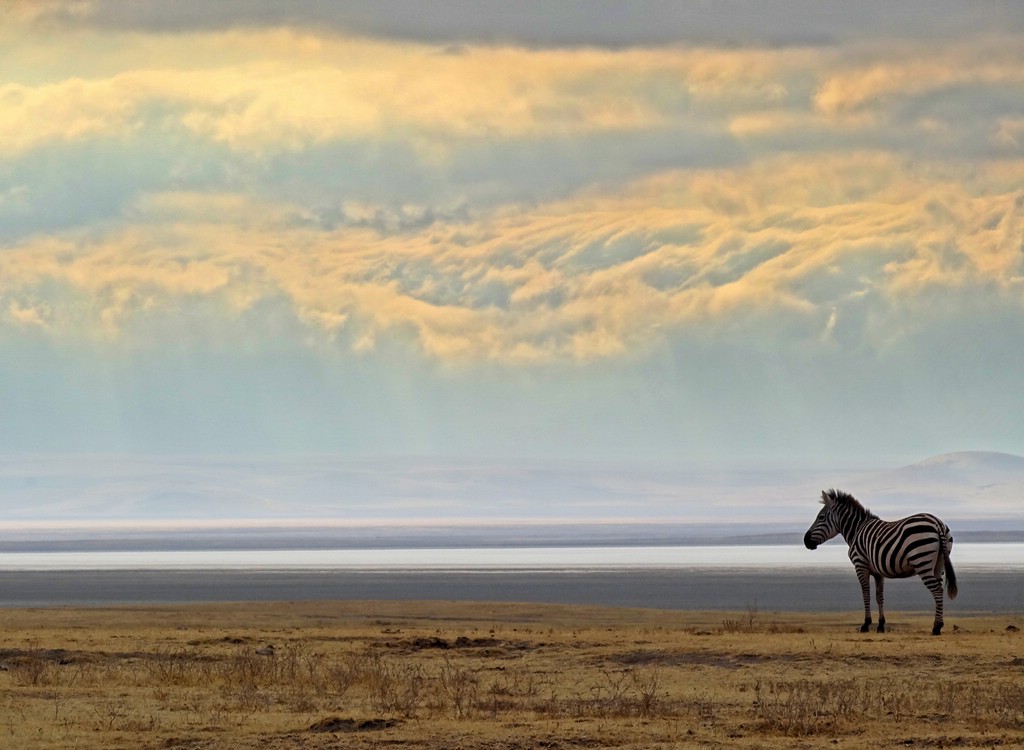 |
| Morning in the Ngorongoro Crater |
Clearly, Exodus had only paid for the half-day thing, so we were rushed out of the crater just in time for the twelve o'clock deadline. Our truck had been fixed with duct tape and string, so we picked it up again and started driving towards Arusha. On our way we passed Lake Manyara, described in the tour itinerary this way: "We continue our journey through beautiful country, where there is a great view over Lake Manyara, often tinted pink around the edges from large numbers of flamingos". We enjoyed that view for a full half second in a sharp bend on the road through the windows of the truck. I can't say I treasure that memory.
We stopped at the Maserani Snake Park Camping for the night. It's a safe place with no locals at all around. The exception is a rather sad-looking display of fairly local live snakes, birds and monkeys. The showers there were hot, or at least offered a rich experience of electrical shocks.
Day 10 was spent getting back to Kenya, to get to the last national park on our trip; Amboseli. Our truck broke down completely, still upset from the battering it had received in the Serengeti a couple of days earlier. It was the best thing that happened that day. As we had to wait for a plan B to emerge, there was nothing sheltering us from the curious locals who could now enjoy the view of miserable foreigners. Oh, how quickly the roles can change on the scene of life! Anyway, some of us went over to them and enjoyed a couple of hours of entertaining conversation and mimics with them. Eventually a bus from the national park arrived to bring us to our camp. No safari that day.
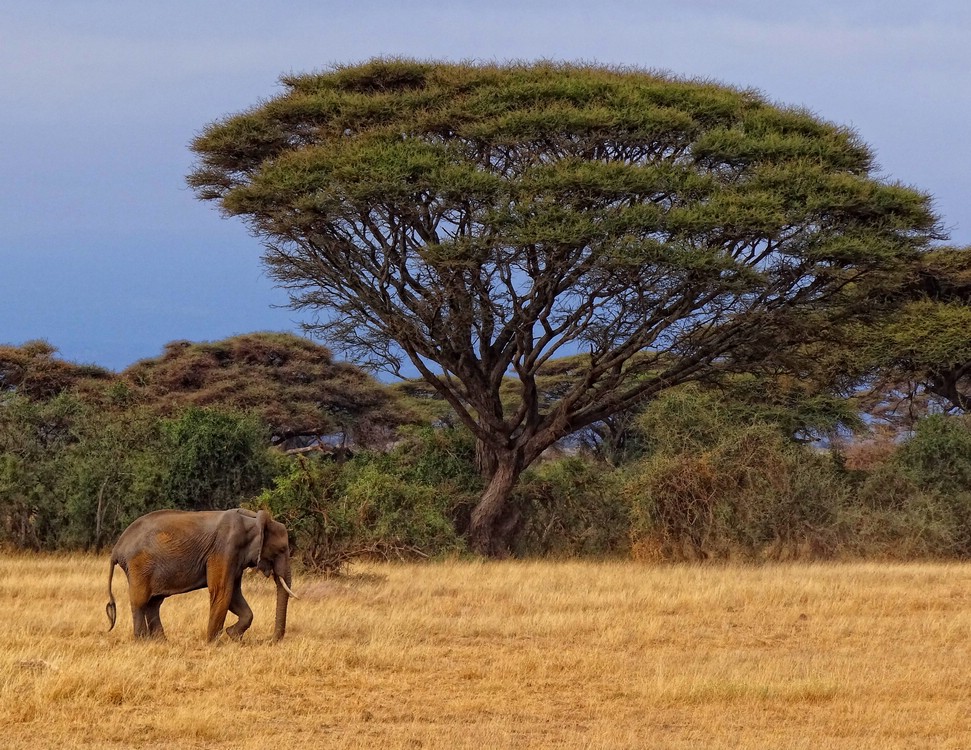 |
| This is Amboseli! |
That was okay, because the last full day of our tour was spent on a game drive in Amboseli, seeing mainly the numerous and large elephants the park is so famous for. I quite enjoyed it. I also enjoyed the camp site, although it was the most basic one on the trip. The facilities were two showers and two toilets a long walk away from where we pitched our tents. The only items for sale in the area were water and beer, sold straight from a portable non-electric cooler in a tent-like construction nearby. We received the usual safety brief telling us not to leave the immediate proximity of the camp, or else. The amusing bit was that while all other camps in the area seemed to be located behind two or three layers of tall, electrical fences, all that kept the animals away from us were thorny branches that had been gathered and piled up around us. To minimize our protection, we used those very branches as firewood throughout the evening.
Finally we spent a full day driving back to Nairobi. To be precise, we spent most of the day driving IN Nairobi. The worst bit was spending 2 hours and 45 minutes on just under 7 kilometres of insanely slow and crowded traffic. We could of course have walked it much faster, but it's likely that we would have become victims of a wide range of crimes on our way. Including all the waiting at the police station that would necessarily follow, we probably would not have saved much time.
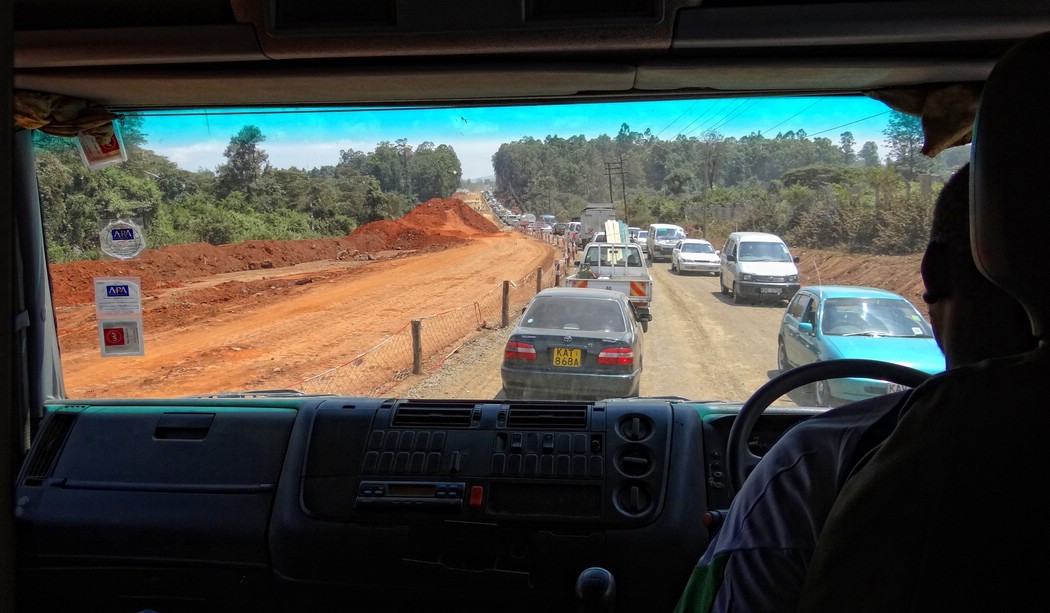 |
| Nairobi traffic jam |
So there you have it.
Did I have a good time in East Africa? Yes, definitely! I came for the animals, and I got lots of animals.
Was I happy with the way the Exodus conducted the trip? Not. At. All.
Upon returning to Norway, I contacted Exodus and basically asked them about the discrepancies between how they present their tours and how they actually operate them. They did respond promptly and politely, and they seemed to be honestly concerned regarding several of the issues I brought up. They were even nice enough to offer me a small compensation, "as a gesture of goodwill". (That was not my goal, I just wanted some answers, so I turned it down.)
That said, I got the feeling that their actual response is that this trip, the East Africa Safari (code AQW), is only sold as an Exodus tour, but it's actually run by a local operator who is free to conduct the tour the way they deem best. As long as choices are made to ensure that no one gets in harm's way, that is of course a good thing. However, as I have discovered, it may lead to much frustration in groups where some people are experienced travelers and others are the opposite, yet the same restrictions, cautions and schedules are applied to everyone.
If you know how to travel, you will always have a better experience on your own than on a mixed group like this. Sometimes joining a tour is still just the most practical or sometimes only way to go where you'd like to. If you pick a tour at the lower end of the price range, like the one described here, be prepared to spend much time around sunset and sunrise doing chores instead of exploring and taking photos. Going on a pricier tour will leave you with more time on your own. There's also the option of not booking ahead, but instead just go to Nairobi and Arusha and book your tour from there. You will get "better" (as in more comfortable lodging, better food and at a slower pace) tours there at the same or even lower rates than what I paid for the Exodus trip.
These are the main issues I had with the tour:
Morning procedures
Early morning is the best time for watching wildlife. You get up, you have a cup of hot tea or chocolate, and then you go out to see the animals before the sun rises and makes them go sleep in the shade. We wasted most of our mornings on eating and doing chores instead.
Safari guiding
While our guide was fairly good at identifying the animals we saw, he was not at all enthusiastic about it and only sparingly offered any information about the wildlife. As I was having exciting wildlife experiences, he managed to fall asleep and not participate in the animal spotting at all.
 |
| Meet Julius! |
Photography
Exodus do offer special tours for photographers, but this wasn't one of them. Still, our driver and our guide were really bad at positioning the vehicle for optimal photographies. If that's important for you, you probably want to seek out a different trip.
Fear mongering regarding the animals
I've already mentioned the lack of quality information regarding the wildlife. The one thing we had more than enough of, however, were statements about how dangerous the animals are. I've been on many safaris, and I have never heard such exaggerated warnings from the tour guide about what we should absolutely not do, because then this or that animal would come and hurt or kill us.
That's just not fair on the animals.
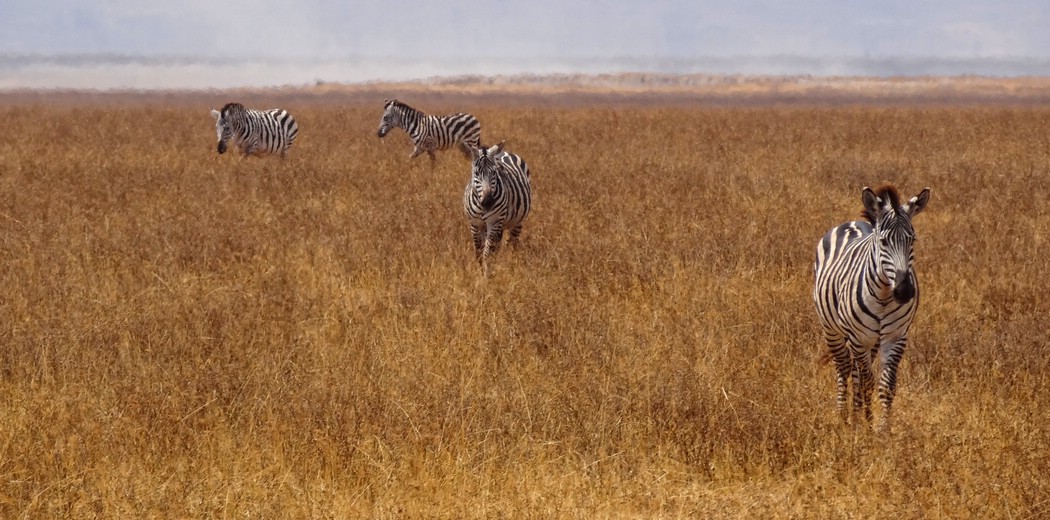 |
| Mostly harmless |
Fear mongering regarding the people
We were repeatedly warned against the risk of thieves and stone throwers. I've traveled quite a bit in Africa, and I think I know what dangers encounters with the locals can involve, and it's nowhere near as bad as what we were told on this trip. The result? Most of the people on our tour talked only to the others on the truck. I feel they missed out. We were rarely given opportunities to interact with Africans, instead we were encouraged to stay in the camp and never leave the vicinity of the truck.
That's just not fair on the people.
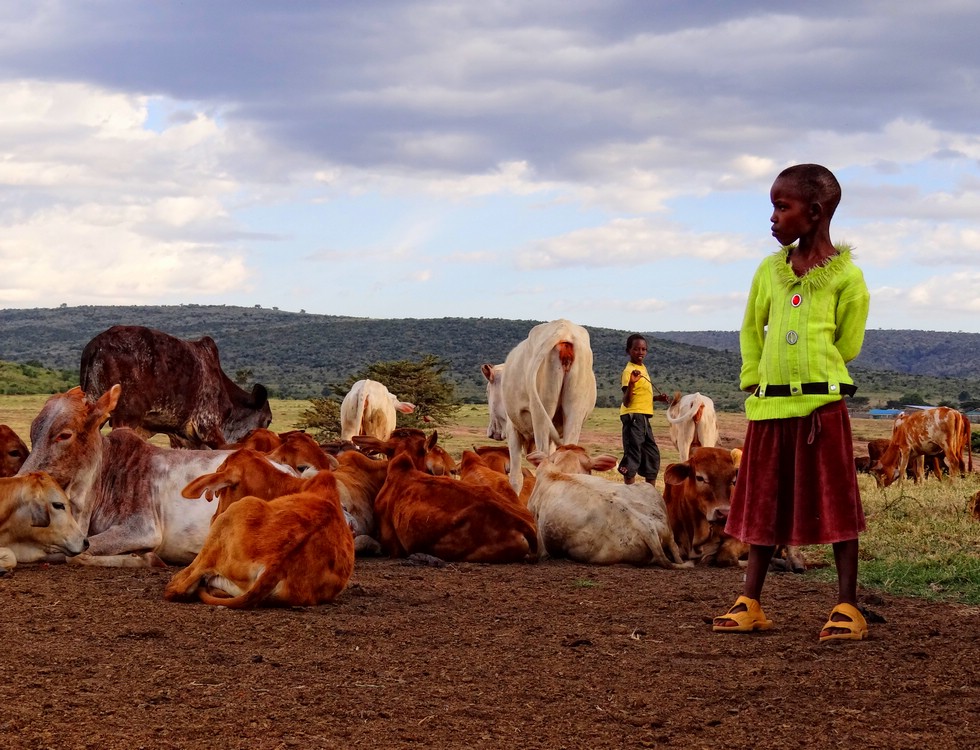 |
| Definitely harmless |
Mismatch between itinerary and reality
I read the itinerary with optimistic eyes, so my hopes were crushed a few times. Most of the optional activities were just impossible to find enough time for.
Financial guiding
Exodus emphasizes that they aim to operate in a responsible manner. In my opinion, that should include informing their clients about roughly how much they should spend on various items, instead of just dropping people off into hoards of people out only to maximize money drainage from tourists. At least on this tour there was none of that. Quite the opposite happened, actually. We were invariably advised to shop at places that were much more expensive than neighbouring shops.
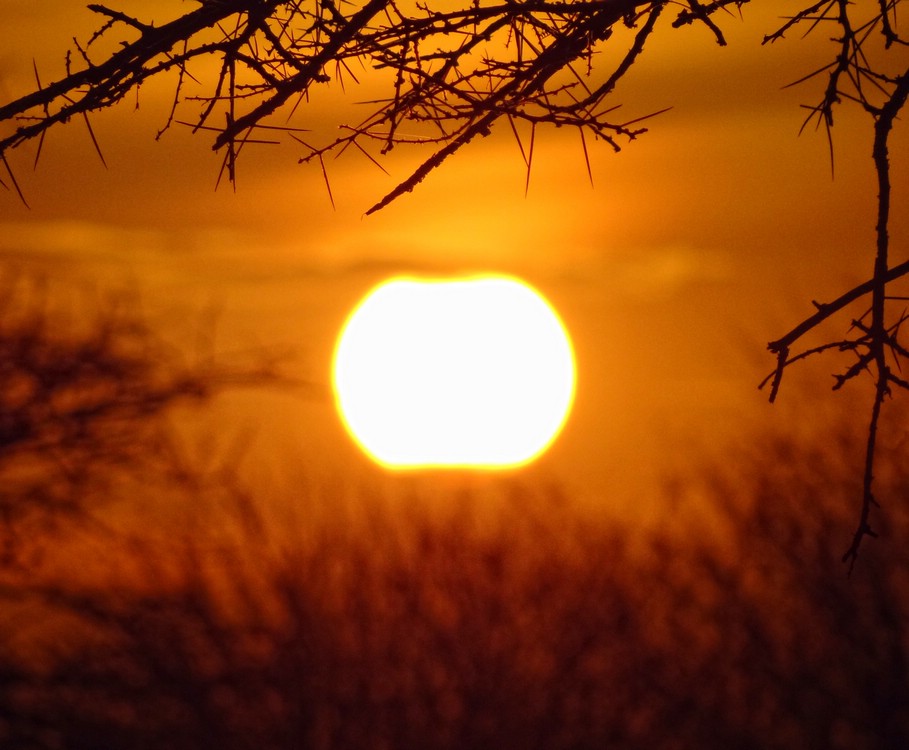 |
| Closing time |
In the end, however, I did get to see lots of great stuff on this trip. Although I just know it could have been even better, I won't grumble more about than I have done now. Thank you for bearing with me.
I'd love to read your experience from this or similar tours, so go ahead and make your comments below!
Happy trails! #8D)
Tuesday, August 14, 2012
What Kenya do?
After having watched this brilliant piece of convincing journalism, sponsored by the Kenyan Tourist Elimination Bureau, I've decided to go to Eastern Africa:
Their main point seems to be that Kenya isn't Norway, which is great. I've been in Norway for 6 weeks now, and all the country can offer me is a job, pleasant temperatures and whining locals. This is not good enough in 2012, richest country in the world!!1!
I've done a lot of research on Africa, so I know exactly what I'm in for. The only slight problem is that I am going to Africa together with this:
(Transcript: "There are a lot of ants here. Waaaah! I just realized I'm sitting almost in a spider web!")
Fortunately, the movie was recorded before I met this person. I do believe I have taught her well, so this might work out still.
First we're going to live on a farm for four days, in a safe distance from Nairobi. As the farm (http://swaraplains.com/) is huge, 81 square kilometres, and the bush is full of cheetahs, I'm pretty sure we'll be able to pass the time there. Most of the time we'll just be walking around, on our own. We can do this, because supposedly there are no lions, rhinos, elephants or buffalo there, so the chance of being eaten or trampled is manageable. They do have ants, though, which may be a problem for someone who isn't me.
Then we'll be going on a tour of the main national parks of Kenya and Tanzania. The full probably itinerary is at http://www.exodus.co.uk/holidays/aqw/itinerary if you want to see it, but the short version is sufficient to me: Masai Mara, Nakuru, Serengeti, Ngorongoro og Amboseli. Woohoo! (That last one isn't one of the places, but my little cry of pleasure.)
As a bonus, on our way home we grab another country, Qatar, where we'll walk around for a full day mumbling something about crazy rich people.
I intended to blog about my pilgrimage through Italy this summer, but due to no miracle providing me with more time, that will have to wait. (Shame on You, oh Lord!) The photos, however, are ready for you to see, so do have a go at http://www.pvv.org/~bct/via/ and see how many you can manage before needing a break.
I bet there's plenty of broadband Internet connection to be found in Africa, so there will probably be lots and lots of blog entries here shortly.
Cowabunga! (Swahili for goodbye for now, I think.)
Their main point seems to be that Kenya isn't Norway, which is great. I've been in Norway for 6 weeks now, and all the country can offer me is a job, pleasant temperatures and whining locals. This is not good enough in 2012, richest country in the world!!1!
I've done a lot of research on Africa, so I know exactly what I'm in for. The only slight problem is that I am going to Africa together with this:
(Transcript: "There are a lot of ants here. Waaaah! I just realized I'm sitting almost in a spider web!")
Fortunately, the movie was recorded before I met this person. I do believe I have taught her well, so this might work out still.
First we're going to live on a farm for four days, in a safe distance from Nairobi. As the farm (http://swaraplains.com/) is huge, 81 square kilometres, and the bush is full of cheetahs, I'm pretty sure we'll be able to pass the time there. Most of the time we'll just be walking around, on our own. We can do this, because supposedly there are no lions, rhinos, elephants or buffalo there, so the chance of being eaten or trampled is manageable. They do have ants, though, which may be a problem for someone who isn't me.
Then we'll be going on a tour of the main national parks of Kenya and Tanzania. The full probably itinerary is at http://www.exodus.co.uk/holidays/aqw/itinerary if you want to see it, but the short version is sufficient to me: Masai Mara, Nakuru, Serengeti, Ngorongoro og Amboseli. Woohoo! (That last one isn't one of the places, but my little cry of pleasure.)
As a bonus, on our way home we grab another country, Qatar, where we'll walk around for a full day mumbling something about crazy rich people.
I intended to blog about my pilgrimage through Italy this summer, but due to no miracle providing me with more time, that will have to wait. (Shame on You, oh Lord!) The photos, however, are ready for you to see, so do have a go at http://www.pvv.org/~bct/via/ and see how many you can manage before needing a break.
I bet there's plenty of broadband Internet connection to be found in Africa, so there will probably be lots and lots of blog entries here shortly.
Cowabunga! (Swahili for goodbye for now, I think.)
Saturday, June 9, 2012
A Way That Leads to Rome
Two years ago I walked the Camino de Santiago, an 800 kilometer pilgrimage from France through Spain, and it was a great experience. Although being a fairly strenuous hike, I felt stronger every day, I got to see daily life play out in small places I had never heard about before, and at the end of the journey a strong feeling of accomplishment was my reward.
I'm still a devoted atheist, but now I'll be going out on a Holy Walk again. On Sunday I'll fly to Milan. Monday morning I'll continue on the train to Fidenza. There I'll get my credencial, a pilgrim passport, and then I'll get going on Via Francigena, the old route from Canterbury to Rome, where there are still some 600-700 kilometers left of it. It's soon time to prepare the tea, Pope! I'm coming your way!
As far as loading up an iPad with podcasts counts as preparations, I'm well prepared for this walk. The beginning of my journey will at least be easier than the previous one was. The last thing I did before leaving from home to walk the Camino was to run a half marathon in Oslo.
Also, this time I won't have to start by hiking across the Pyrenées. I've had a look at the map, and this looks like a nice and easy walk, although it may be a hot one. I'll be walking through Lombardy, Parma, Emilia-Romagna, Liguria, Tuscany and Lazio, all the way to Rome. You can easily put " Ham" behind all of those, and that bodes well. Apart from the names of the regions, I don't really know where I'm going. I do, however, look forward to observing everyday life in Poggibonsi, which is the funniest-sounding place I've discovered on the map so far.
Via Francigena doesn't have all the facilities of the Camino de Santiago, so I may be sleeping outside a bit more than usual this time. Which may be a good idea anyway, with all the earthquakes in Italy lately.
However, the Italians would love to have more visitors come for a walk and to spend some money there, and I've found a couple of places along the way where they're actually competing in showing the most hospitality towards pilgrims this summer. Someone here at home is a bit worried the Italians may be a bit TOO friendly towards me. She has decided to remedy that by giving me a good, old, home-made haircut before she'll let me leave.
I'll be bringing a hat.
With a bit of luck, I may find some Internet along the way. If so, you'll be hearing from whatever is left of me by then. (I don't expect to gain much weight this summer.)
Hallelujah.
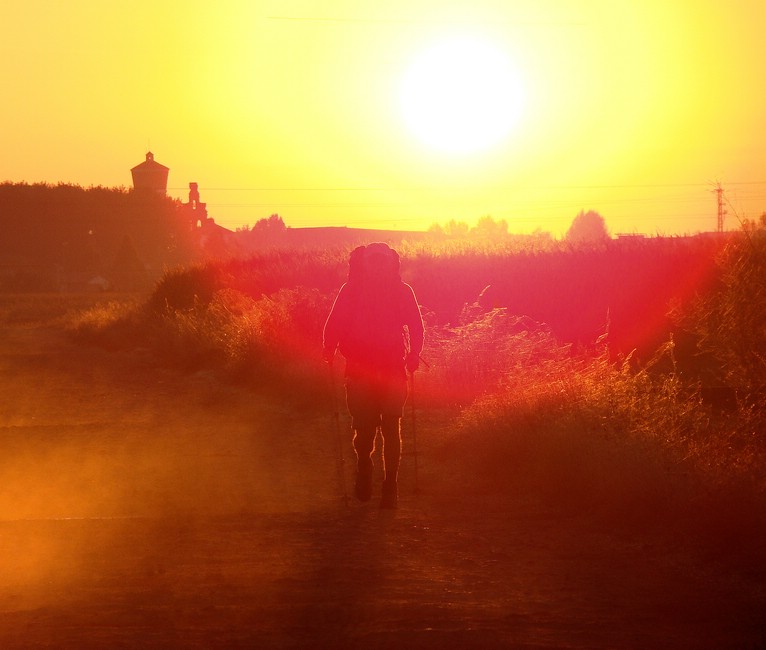 |
| This. |
As far as loading up an iPad with podcasts counts as preparations, I'm well prepared for this walk. The beginning of my journey will at least be easier than the previous one was. The last thing I did before leaving from home to walk the Camino was to run a half marathon in Oslo.
Also, this time I won't have to start by hiking across the Pyrenées. I've had a look at the map, and this looks like a nice and easy walk, although it may be a hot one. I'll be walking through Lombardy, Parma, Emilia-Romagna, Liguria, Tuscany and Lazio, all the way to Rome. You can easily put " Ham" behind all of those, and that bodes well. Apart from the names of the regions, I don't really know where I'm going. I do, however, look forward to observing everyday life in Poggibonsi, which is the funniest-sounding place I've discovered on the map so far.
 |
| I'm somewhere around here! |
However, the Italians would love to have more visitors come for a walk and to spend some money there, and I've found a couple of places along the way where they're actually competing in showing the most hospitality towards pilgrims this summer. Someone here at home is a bit worried the Italians may be a bit TOO friendly towards me. She has decided to remedy that by giving me a good, old, home-made haircut before she'll let me leave.
I'll be bringing a hat.
With a bit of luck, I may find some Internet along the way. If so, you'll be hearing from whatever is left of me by then. (I don't expect to gain much weight this summer.)
Hallelujah.
Friday, June 1, 2012
Like a Lazy Whirlwind Through Ireland
The last you heard from me was that I plotted my next escape from arguably the best country in the world to live in. I ended up going to Ireland. I've long since returned home, but while the photos from the trip
are right where they should be, the tale of my journey has been missing. Until now. Here it is.
Short version: I had a great time, although I did acquire a bit of a sunburn while having four sharks circling me. Enough to tickle your curiosity? If so, hang on for the unabridged version below.
The deal this time was that just as I was leaving work for a month, I discovered that the weather forecast for Ireland was an extremely rare two weeks of sun! A day or so later I was on a plane to Dublin, where I landed in the middle of the Saint Patrick's Day celebrations.
As usual, I skipped the beer and shouting part and visited the National Museum of Natural History instead. It claimed to have just reopened after some major refurbishing, but there were no Furbies on display, and if they really had tried to fix up the exhibits a bit, I would be very interested to see photos of what the place looked like before they started. I've never seen a worse-looking large collection of antique works of taxidermy. Here are some examples for you:
I heard a little girl ask her father if the specimen she was looking at was a giraffe, a kangaroo or a bat, and frankly I was wondering the same myself. "Let's go get some ice-cream", he suggested. Smart man.
As soon as I could find a sober bus driver after the national holiday, I went west, to Cashel. It's a small town, but strange things happen even in small places. In this case, the strange thing was that I was locked up by someone, and the police had to come and rescue me. Of course, usually it's the other way around. Like in the case of Robin Hood. But that was in England, and Ireland is anything but England.
Anyway, I was being a good tourist, entering the town's visitor center to ask where I might rent a bike. There was a line, which I don't like much, so I went to another room to have a look at the temporary exhibition "Stuff written by fifth graders about boring local history". Just as I was about to fall asleep, I pulled out of it and went back to see whether the line was gone.
It was. And so was the woman that had been servicing it. "That's funny", I thought, in a not amused way. The front doors were locked. So was the back door. And the windows. I found a phone behind the counter and called all my friends in Australia, before I finally called the police and explained that if anyone had reported a burglar in the visitor center, that was not the case, and could they please come and get me.
The oldest policeman in Ireland was dispatched, the guy that is so beyond useful that he can't even help cats down from trees anymore. He had some special gear and started working his magic on the locks, but he only managed to unlock one of the two locks on the door. Eventually some special unit for stupid tourist incidents had managed to locate the woman that had locked me up, and brought her to get me out of there.
I know the Irish have a reputation for being endowed with much red hair and freckles, but I've never seen anyone anywhere look as red as that woman. And she didn't even have red hair or freckles.
Apart from that, or to be honest actually including that, I quite enjoyed Cashel. It's a small town, where you can't really sing "It's a long way to Tipperary" and mean it. Tipperary is literally next door. At the local fast food shop I found out what melodies the locals like to listen to instead. Here's the top 10 list from the jukebox:
1. Galway Girl, featuring Sharon Shannon. She plays the fiddle and the accordion, and her other big hit is "What You Make It (da, da, da, da)". I'm sure she's a very talented woman.
2. The Gambler (Kenny Rogers). Winning the Lotto has been the most likely way to make any decent money in Ireland lately.
3. Crazy World (Aslan). A sad song for tough times. It's a long song, so you get a lot of music for your money with this one. Not made by a lion, despite the name of the band.
4. Fisherman's Blues (Waterboys). A tale about the kind of people who at least can get their food straight from the sea, even when they can't afford to get it from the shop any longer.
5. Sweet Child O' Mine (Guns N' Roses). Somewhat disturbing in a Catholic country, if you ask me.
6. Down Under (Men At Work). Obvious choice, now that half of Ireland (the young ones) are considering leaving for Australia to find work.
7. A Nation Once Again (Wolfe Tones). Close enough to the national anthem of Ireland, written in 1840 and continuously being covered by every band of any importance as the times go by.
8. Apologize (Timbaland). What? An actual pop song on the list? Wow!
9. Big Girl - You Are Beautiful (Mika). Motivational music written especially with fast food outlets in mind.
10. Heaven (Bryan Adams). There are many believers around here.
Or are there? After all the scandals with sexual abuse of children within the Catholic Church of Ireland (and elsewhere) lately, religion in Ireland has taken a heavy hit. But in Cashel the old churches and graves are still standing proud, as beautiful and useless as ever.
I moved on to Cork. It's just the second largest city in the country, but thanks to its many students, I'm pretty sure they drink even more alcohol per capita there than they do in Dublin. And they've got the nation's tallest building that isn't a church, "The Idle Tower".
The buildings real name is "The Elysian", and it was originally intended as the most prestigeous apartment building in Gingerland. Then the financial crisis came and toppled the project. Now the place is 99 % done, but close enough to still being empty. Only the parking lots in the lower floors seemed to be in use. But the Irish sense of humour lives on in building's nickname.
Cobh is a lot cozier. It's a suburb of Cork, located closer to the ocean. It was from here that the Titanic left on her first and last attempt at crossing the Atlantic. Since then, all they've been doing in Cobh is to try and maintain their way too large cathedral and to build various Titanic museums.
I particularly enjoyed the exhibition where seasickness was emphasized. Several scenes showed people who were pretty green in their faces and/or had their heads buried in buckets semi-filled with some yellow-brownish goo probably containing a considerable amount of stomach acid.
The Butter Museum in Cork, which actually is a place that exists, can safely be ignored, though.
By now I was done with the city life, so I moved on to Killarney. "Poor Arney!", you may think, but there's no reason to worry. By Irish standards, Killarney isn't even a slightly strange name for a place. Here are a few other ones:
But let's stick to Killarney for now. It's a place for walks in the forest and along the lakes and for hiking in the mountains, enjoying a landscape that at its best reminds me quite a lot about my own Norway. I had no problems at all imagining trolls having just run off to their hiding places every time I turned a bend on the trail through the forest.
What you need to look out for in Killarney are the sly guys with bikes for rent. "Here, take this bicycle, it's brand new, you'll never have any problem with it", they say. Then you bike for 20 kilometres into the wilderness, you have a puncture, and you realize that the only thing to do is to walk your bike another 20 kilometres along the route you had planned back to town. When you return to the rental place, the guys there suddenly say "Oh, you were going to actually use the bike outside the town. Ah, yes, roughly half of our customers who do that experience experience a puncture. Ha-ha." And then you feel a little bit stupid and fooled, but mostly just really, really tired.
Still, I'd love to go up there again, but not without a pump and a mending kit for the bike. Or even better; get someone to drive you to Kate Kearney's Cottage and then hike the 25-30 kilometres from there across the mountains and along the lakes, with great chances for hitching a ride the last 10 kilometres or so to Killarney. In nice weather, that's pretty much a perfect day trip, I imagine.
Having worn myself out in the Irish mountains, I decided to return to the coast. There are several fingers of land stretching west towards America from Killarney, and I chose the Dingle one. Mostly by random, but also a little bit because it's the one the leads to the westernmost point of "mainland" Ireland. Also, it's got Fungie, an amazingly friendly wild dolphin that has been living on the Dingle waterfront for more than a quarter of a century now, so there's probably little time left to see him now.
Again I ventured out on a bicycle, this time fortunately with no incidents. It's a beautiful ride, doing the Slea Head Drive, a loop starting and ending in Dingle via the westernmost extremity of Ireland.
This early in the year there weren't many other tourists around, but I cherished the ones I saw. Few things can make me more happy than having a whole day at my disposal to enjoy great scenery at my own pace. My happiness is even further enhanced when on a day like that, I encounter a busload of people looking longingly out at me from behind bus windows, obviously wishing they could trade places with me.
You need to take your time when you visit the Dingle Peninsula. The scenic views just keep on coming at you, and the road is generally so narrow that if you're in a car, there are just a tiny number of places where you can actually stop for long enough to get out and enjoy the views. If you go there, make sure to include an overnight stay or two. Incredibly, you can visit on a day trip from Dublin, but going on a trip like that is only good for inducing gastric ulcers.
Two buses with a half-day pause between them in Limerick let me move on to Doolin.
Doolin is almost nonexistent. There's one street, Fisher Street, with buildings only on the north side of it, with a hostel, two pubs and a couple of knitwear stores where you can buy an emergency wooly sweater if you need it. Which you often do in Doolin, I imagine. But the thing Doolin has going for it, is that it's a great place to start walking. You can go north-east, towards the peculiar rocky landscape of the Burren, or you can go southwest, towards the Cliffs of Moher. I did the latter, and rarely have I seen cliffs as beautiful as them anywhere else in the world.
Just walk along the edge, only as far away from the precipice as you must to feel comfortable. The wonders will gradually reveal themselves for you with ever increasing intensity. On your way you will meet huge numbers of oystercatchers, murres and the cutest puffins. The density of cows and sheep means crazy numbers of manure flies as well, but on the edge of the cliffs the wind is usually strong enough that they just blow past you without bothering you too much. As long as you manage to keep your mouth shut, that is. But do keep your eyes open! There are already sufficiently many crosses and plaques along the trail, put up in memory of those who have fallen off the cliffs or drowned at sea there.
If it's a good day, you may be lucky enough to see some insane surfers play in the ginormous waves just off the cliffs. I saw them, but I counted myself even luckier when a little while later, four basking sharks, the second largest fish on the planet, showed up with their huge white mouths, "grazing" for plankton. I spent a long time just sitting there and enjoying the rare show. That's the spirit, Nature!
Pretty high on scenery and wildlife, my time in Ireland had run out. I had to head back to Dublin to catch my plane home. Thanks to free wifi on the Galway-Dublin express bus, that took no time at all.
In conclusion, my opinion is that Ireland is a country where you can travel for weeks and weeks, and if you go, make sure to bring your best walking shoes. Dublin and Cork can have two or three days each, but the highlights of Ireland are mainly found along the west coast, in places with strange names you have never heard and that you could never have come up with yourself. Just try, and you'll see that I speak the truth.
Fun fact: To travel between the Dublin city center and the airport, you have to go on bus 747. On the photo above, you can see what it looks like from the front seat of the top deck of that very bus as it takes you up the iconic O'Connell Street.
Since returning home I've been working quite a lot, but I'm soon to head out on another journey. Check back here, and I'll soon reveal to you where I'm going.
Short version: I had a great time, although I did acquire a bit of a sunburn while having four sharks circling me. Enough to tickle your curiosity? If so, hang on for the unabridged version below.
 |
| "Gidday! What's going on here?!" |
As usual, I skipped the beer and shouting part and visited the National Museum of Natural History instead. It claimed to have just reopened after some major refurbishing, but there were no Furbies on display, and if they really had tried to fix up the exhibits a bit, I would be very interested to see photos of what the place looked like before they started. I've never seen a worse-looking large collection of antique works of taxidermy. Here are some examples for you:
 |
| Clockwise, starting in the upper left corner: a frying pan monkey, a penis ape, a button-nosed rabbit, a yellow-eyed fnuff and a flying flashing rat.I bet you didn't even know they existed. |
As soon as I could find a sober bus driver after the national holiday, I went west, to Cashel. It's a small town, but strange things happen even in small places. In this case, the strange thing was that I was locked up by someone, and the police had to come and rescue me. Of course, usually it's the other way around. Like in the case of Robin Hood. But that was in England, and Ireland is anything but England.
Anyway, I was being a good tourist, entering the town's visitor center to ask where I might rent a bike. There was a line, which I don't like much, so I went to another room to have a look at the temporary exhibition "Stuff written by fifth graders about boring local history". Just as I was about to fall asleep, I pulled out of it and went back to see whether the line was gone.
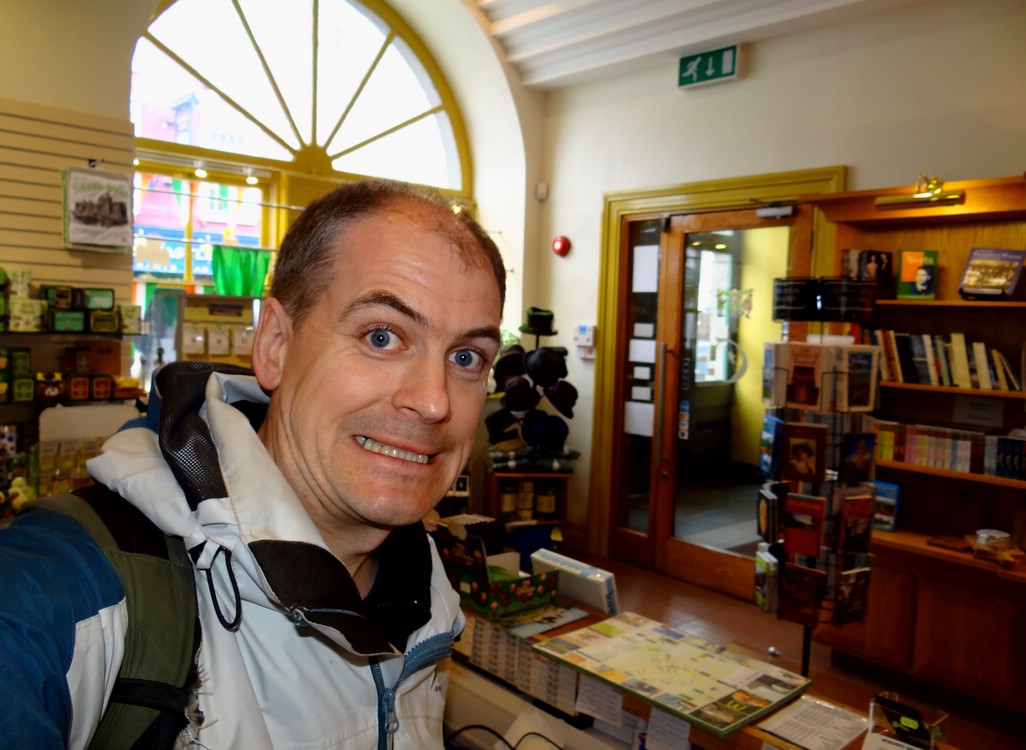 |
| Entirely captivated, Wallace and Grommit style. |
It was. And so was the woman that had been servicing it. "That's funny", I thought, in a not amused way. The front doors were locked. So was the back door. And the windows. I found a phone behind the counter and called all my friends in Australia, before I finally called the police and explained that if anyone had reported a burglar in the visitor center, that was not the case, and could they please come and get me.
The oldest policeman in Ireland was dispatched, the guy that is so beyond useful that he can't even help cats down from trees anymore. He had some special gear and started working his magic on the locks, but he only managed to unlock one of the two locks on the door. Eventually some special unit for stupid tourist incidents had managed to locate the woman that had locked me up, and brought her to get me out of there.
I know the Irish have a reputation for being endowed with much red hair and freckles, but I've never seen anyone anywhere look as red as that woman. And she didn't even have red hair or freckles.
Apart from that, or to be honest actually including that, I quite enjoyed Cashel. It's a small town, where you can't really sing "It's a long way to Tipperary" and mean it. Tipperary is literally next door. At the local fast food shop I found out what melodies the locals like to listen to instead. Here's the top 10 list from the jukebox:
1. Galway Girl, featuring Sharon Shannon. She plays the fiddle and the accordion, and her other big hit is "What You Make It (da, da, da, da)". I'm sure she's a very talented woman.
2. The Gambler (Kenny Rogers). Winning the Lotto has been the most likely way to make any decent money in Ireland lately.
3. Crazy World (Aslan). A sad song for tough times. It's a long song, so you get a lot of music for your money with this one. Not made by a lion, despite the name of the band.
4. Fisherman's Blues (Waterboys). A tale about the kind of people who at least can get their food straight from the sea, even when they can't afford to get it from the shop any longer.
5. Sweet Child O' Mine (Guns N' Roses). Somewhat disturbing in a Catholic country, if you ask me.
6. Down Under (Men At Work). Obvious choice, now that half of Ireland (the young ones) are considering leaving for Australia to find work.
7. A Nation Once Again (Wolfe Tones). Close enough to the national anthem of Ireland, written in 1840 and continuously being covered by every band of any importance as the times go by.
8. Apologize (Timbaland). What? An actual pop song on the list? Wow!
9. Big Girl - You Are Beautiful (Mika). Motivational music written especially with fast food outlets in mind.
10. Heaven (Bryan Adams). There are many believers around here.
 |
| Celtic crosses are slightly better-looking and more mossy than most other crosses. |
I moved on to Cork. It's just the second largest city in the country, but thanks to its many students, I'm pretty sure they drink even more alcohol per capita there than they do in Dublin. And they've got the nation's tallest building that isn't a church, "The Idle Tower".
 |
| An Irish luxury skyscraper in an otherwise run-down neighbourhood. |
 |
| Cramped and old, but the cutest street in Cobh. |
 |
| The cathedral completely dominates the small town of Cobh. |
 |
| Intriguing details! |
By now I was done with the city life, so I moved on to Killarney. "Poor Arney!", you may think, but there's no reason to worry. By Irish standards, Killarney isn't even a slightly strange name for a place. Here are a few other ones:
- Kilbarrack: I reckon the CIA must be paying attention to this place.
- Kilbride: Probably not the most popular destination for honeymooners.
- Graiguenamanagh: A desperate attempt to sound like a place where exclusive whisky is distilled.
- Artfart: Oooh! Fancy!
- Skibbereen: There just has to be lots of sailors living there.
- Knocknadobar: I'm guessing there's a rough bar there somewhere.
- Gap of Dunloe: I'm pretty sure that's a place in Midgard, with lots of Orcs in it.
- Letterfrack: Also known as Envelope?
- Doon Well: No one's ever caught food poisoning there, I bet.
 |
| Dusk by one of the lakes near Killarney. |
 |
| Welcome to the Shire! |
 |
| Don't brace yourself, there's no storm coming, it's just the weather posing dramatically for me. |
Having worn myself out in the Irish mountains, I decided to return to the coast. There are several fingers of land stretching west towards America from Killarney, and I chose the Dingle one. Mostly by random, but also a little bit because it's the one the leads to the westernmost point of "mainland" Ireland. Also, it's got Fungie, an amazingly friendly wild dolphin that has been living on the Dingle waterfront for more than a quarter of a century now, so there's probably little time left to see him now.
 |
| If you turn off the main road on Dingle, you'll almost always end up on a beach like this. Bliss. |
This early in the year there weren't many other tourists around, but I cherished the ones I saw. Few things can make me more happy than having a whole day at my disposal to enjoy great scenery at my own pace. My happiness is even further enhanced when on a day like that, I encounter a busload of people looking longingly out at me from behind bus windows, obviously wishing they could trade places with me.
 |
| A cool mammal, the bravest in its herd. |
 |
| Is it lovely or is it lovely? |
 |
| Retirees and a cherry tree in Limerick. |
 |
| Happiness. |
If it's a good day, you may be lucky enough to see some insane surfers play in the ginormous waves just off the cliffs. I saw them, but I counted myself even luckier when a little while later, four basking sharks, the second largest fish on the planet, showed up with their huge white mouths, "grazing" for plankton. I spent a long time just sitting there and enjoying the rare show. That's the spirit, Nature!
Pretty high on scenery and wildlife, my time in Ireland had run out. I had to head back to Dublin to catch my plane home. Thanks to free wifi on the Galway-Dublin express bus, that took no time at all.
In conclusion, my opinion is that Ireland is a country where you can travel for weeks and weeks, and if you go, make sure to bring your best walking shoes. Dublin and Cork can have two or three days each, but the highlights of Ireland are mainly found along the west coast, in places with strange names you have never heard and that you could never have come up with yourself. Just try, and you'll see that I speak the truth.
 |
| Just another morning in Dublin |
Since returning home I've been working quite a lot, but I'm soon to head out on another journey. Check back here, and I'll soon reveal to you where I'm going.
 |
| I'll be back. (Stolen from a Dingle shop window.) |
Subscribe to:
Posts (Atom)

